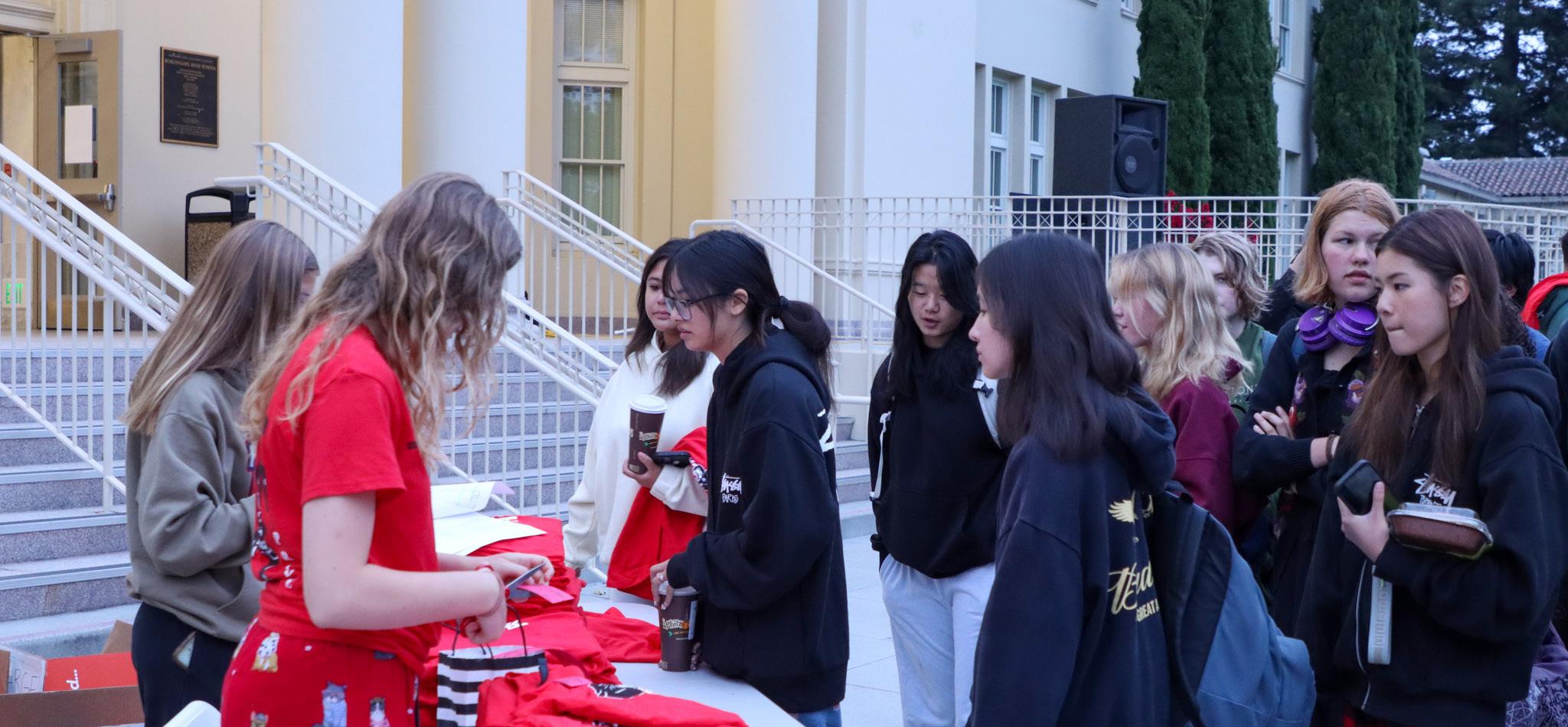What’s Inside:









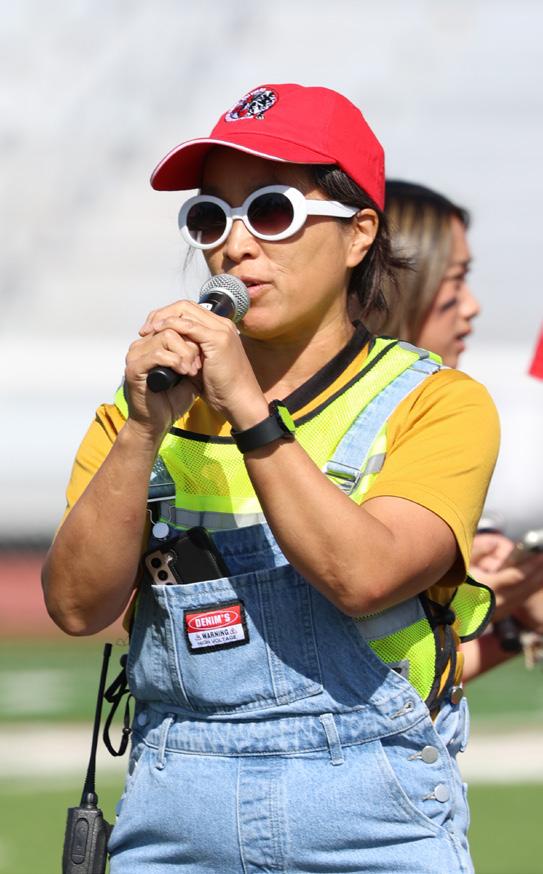
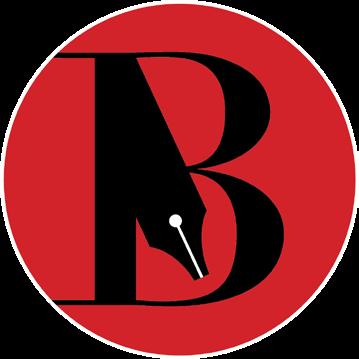
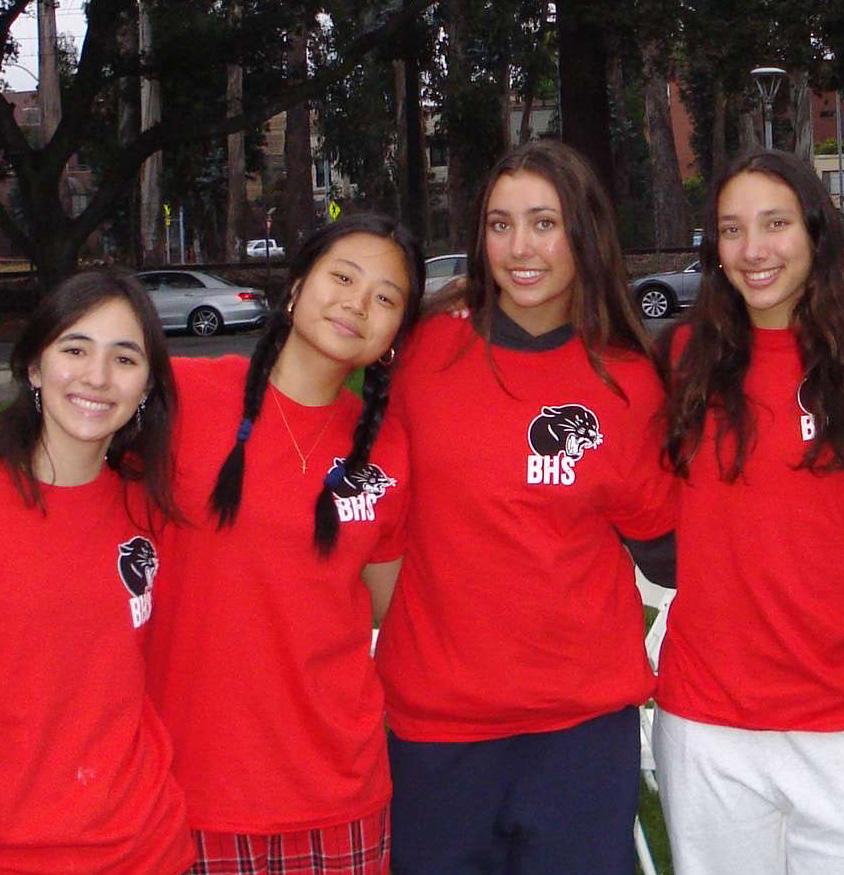

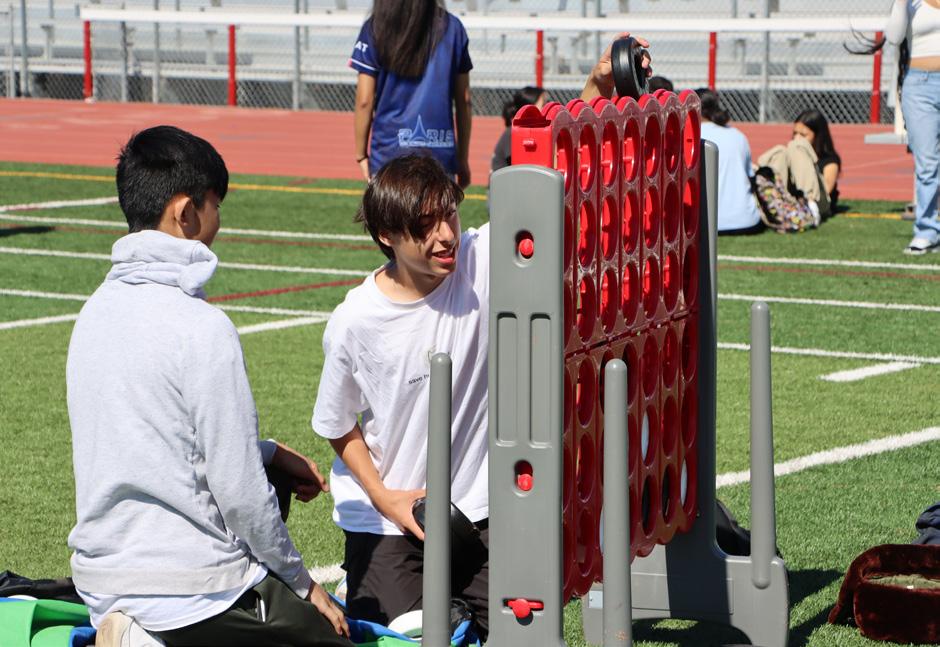

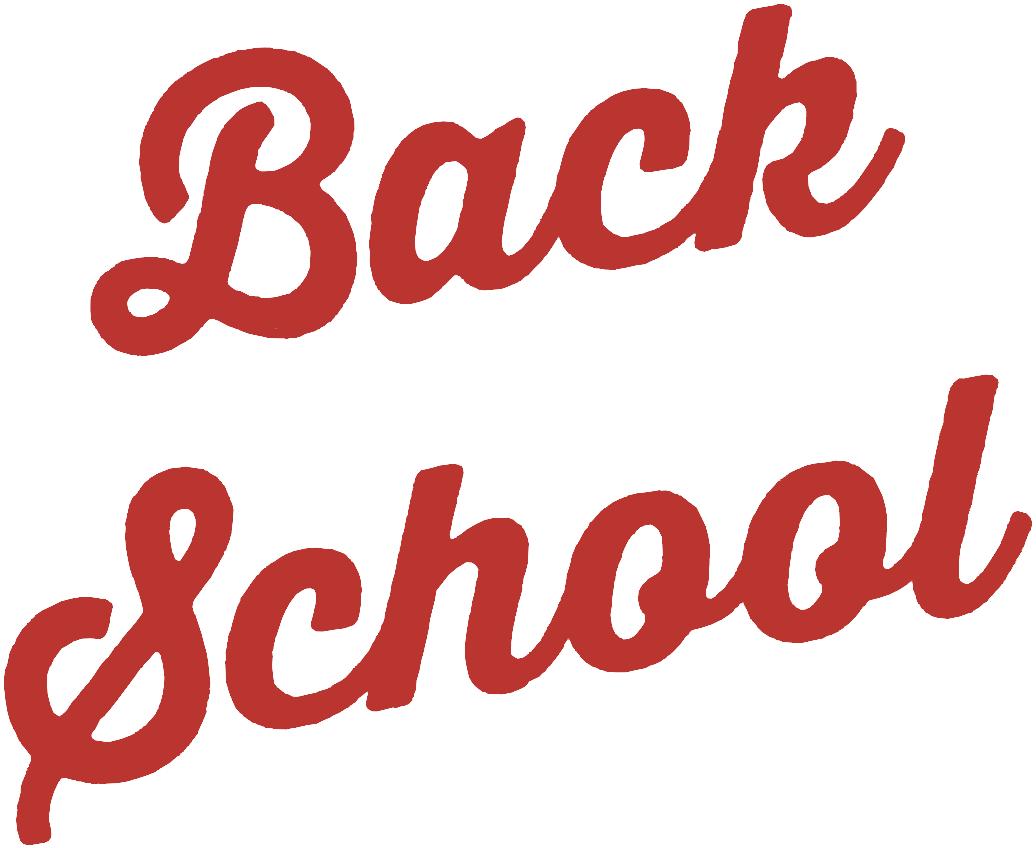

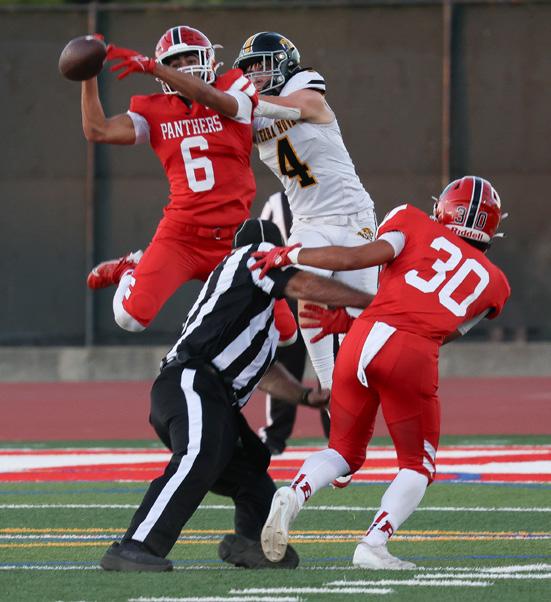

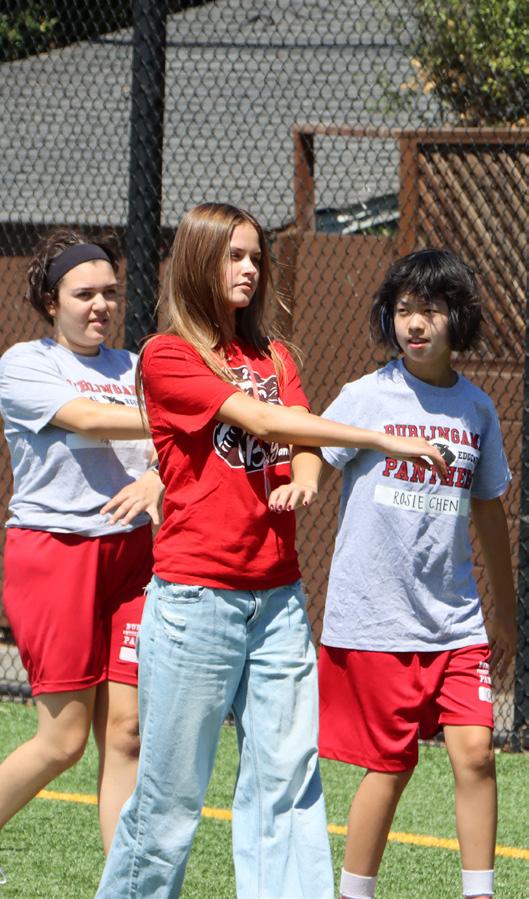
BY JEANNINE CHIANG Managing Editor
It’s not every day that you walk into school and find something completely transformed. But on Monday, Sept. 9, students were greeted by an unexpected, breathtaking surprise: a vibrant mural, 70 feet long, now stretching across the wall above the theater in the A-Building.
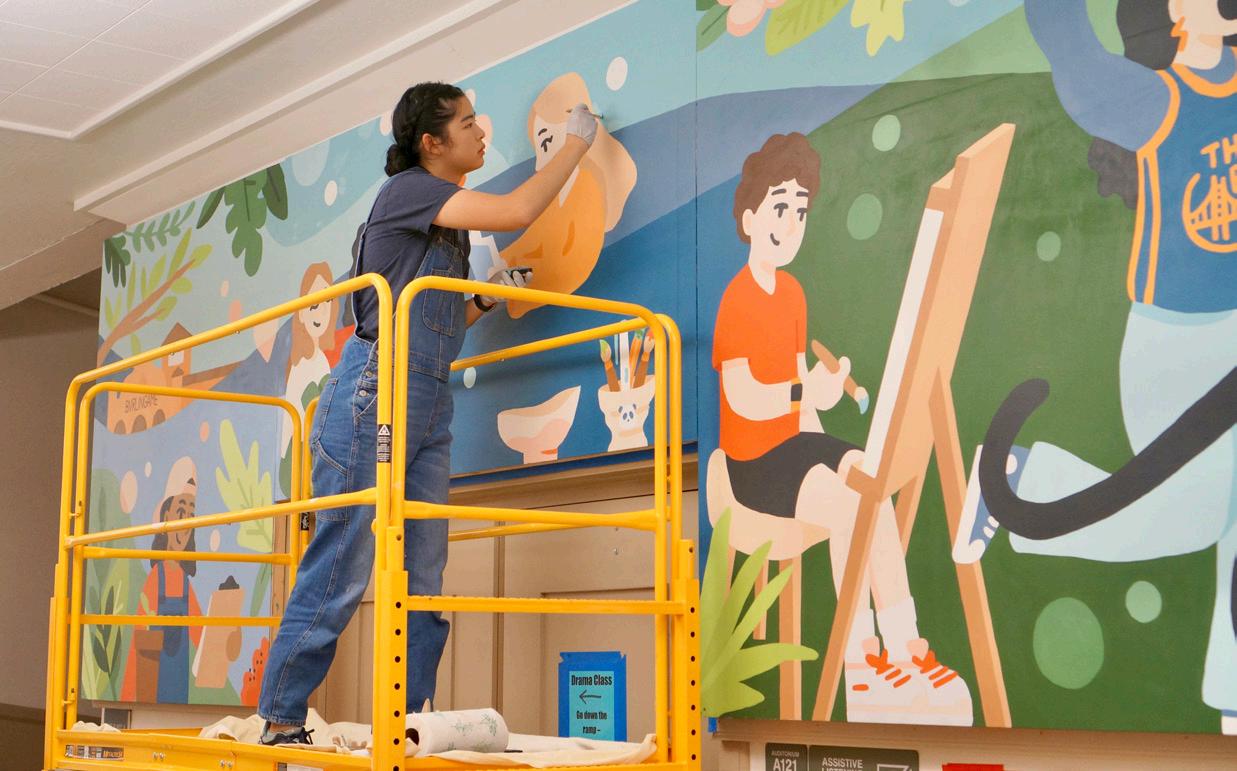

Valerie Arbizu didn’t need much of an introduction when she stepped back into her old role as vice principal at Burlingame this fall. Following the resignation of Karen Bioski-Simon, Arbizu — who held the same position from 2015 to 2020 — answered the call to return, bringing with her a sense of familiarity and experience.
“When it was announced that I was coming back, the staff were really warm and receptive,” Arbizu said. “It’s funny to walk through the halls and know most of the adults and not really know any of the kids.”
Arbizu began her 22-year career in education teaching English in East San Jose before joining the San Mateo Union High School District in 2012, where she became an assistant principal at Mills and then Burlingame. After taking on a position as principal at Aragon, she’s come full circle, once again serving the Burlingame community.
“My areas of passion and education [are] working with counseling and working with students who need a little extra support. I initially had shifted gears to work at the district office in the areas of 504… when [Principal] Fong called to let me know that this position was open again, I was like, ‘I’ll take it, I’ll take it,’” Arbizu said.
Despite new changes — gym construction, administrative shifts, and schedule complications — Arbizu is equipped to deal with these issues.
“I’d like to think of myself as a systems thinker. We’re spending a lot of time here in the counseling office, looking at policy,” Arbizu said. “I come from a place of respect and looking to understand; [what] I tend to ask people when they walk in is ‘help me understand.’”
Due to former counselor Earvin Buckner’s departure, Arbizu’s first intentions were to sort out the issues regarding students’ classes.
“It’s really important to me that students come on the first day of school with a schedule that works for them, but before that, it’s important to me to take everybody’s course requests and get everything in as much as possible,” Arbizu said.
Outside of school, Arbizu’s passions revolve around entrepreneurship and sports.
“I want the mural to make everyone feel represented in some way, whether it’s through their appearance, activities, or personality, as long as it fosters a sense of belonging in our school,” Cheng said.
Since 1973, the space had been dominated by a mural painted by Frederick Alexander Pawla in partnership with the Federal Art Project. The original artwork depicted Manifest Destiny. But for recent graduate Lauren Cheng, the mural felt increasingly out of step with the diverse, evolving spirit of the school she had come to know. So, on Saturday, Sept. 7, with support from Facilities Manager Joseph Tipton and her father, Cheng replaced the old mural with a bold, new vision — one that she hopes will inspire and represent the community for years to come.
Over the past two years, Cheng dedicated nearly 400 hours to the project. She assembled the Diversity Artwork Commission (DAC) to support the early stages of planning, then brought her vision to life, creating a space that she hopes
See MURAL, page 3
“I used to have an Etsy store — I sold fabric arts textiles. Now I’ve moved on to crochet and amigurumi,” Arbizu said. “Also [my family and I] are trying to get to all of the major league ballparks, we’ve already gone to seven this year.”
As the school year continues, Arbizu will continually aid student needs as well as take on larger tasks.
“I’m just really excited to be back. I’m friendly. When my door is open, it’s open for anybody. If students need assistance, I’m here,” Arbizu said.
BY SOPHIA DOSS Copy Editor
The English department reverted to a traditional grading system after four years of using a 4-point scale, according to department co-chairs Melissa Murphy and Mary Dhyne. The shift, which took effect this school year, marks the end of a grading model introduced in 2020 to emphasize equity and skill development over point accumulation.
“After a lengthy discussion, our con list was so much longer than our pro list, the answer was clear that we needed to change back,” Murphy said.
Unlike the traditional scale, the 4-point system doesn’t require teachers to grade students from a 0-100 scale where there are hundreds of different performance-based levels students can meet. Instead, it allows teachers to assign grades from numbers 0ne to four.
“We started talking about the 4-point scale back in 2020 to create equity among students,” Murphy said. “The world language department had been using it for a while so [English] classes started implementing it to see how it went.”
The expectation is that teachers assess students often on various learning modes, which is why the scale works so well for world languages. However, in English, essays are written almost every six weeks and it takes teachers much longer to give feedback.
“I thought it worked really well with the freshman [at first], and eventually I think each grade level kind of adopted it,” Murphy said. “We wanted to move the discussion about skills as opposed to points in a grade. We wanted students to have the language to talk about what they’re learning and what they can do to improve their writing.”
Even though senior Alejandro Pineda Wright noted he didn’t pay much mind to how he was evaluated, he offered that feelings surrounding the system are subjective as it appeals to a certain “type” of student.
“It narrows down a student’s grade to a specific skill set, although I do think that [the 4-point scale] makes it easier for the students who excel during essays and projects,” Pineda Wright said.
Senior Evangeline Scott noted the differences between the 4-point scale and a traditional one often created frustration and confusion for students.
“Because so many of us have grown up getting a percentage it’s kind of a difficult shift, because when you see a two, you’re like ‘oh my god this is so scary’. But in reality it’s a passing grade and not what a 50% would be on a percentile grading scale,” Scott said.
While the 4-point scale has its benefits and makes it easier for teachers to help struggling students, its lack of transparency and fairness makes it difficult to implement in courses like English.
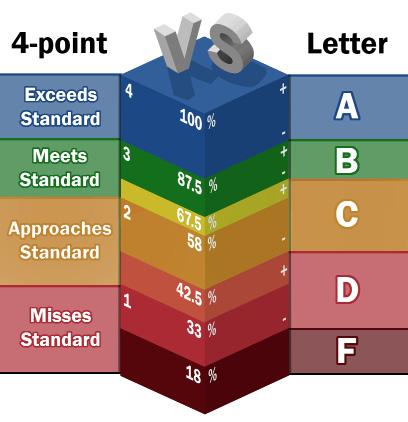
BY INY LI Business Manager
For senior Ryan Wang, a regular Caltrain commuter, it’s the growing similarity between the Bay Area’s newest electric trains and the advanced transit system he grew up using in China that made him realize just how far local transportation has come.
Wang’s excitement is shared by many students who rely on Caltrain for their daily commutes. Since breaking ground in 2017, the $2.44 billion electrification project has aimed to transform the aging diesel-powered commuter rail into California’s first electrified rail system. Stretching over the 51-mile corridor between San Francisco and Silicon Valley, which has been in active use for 160 years, these modernized electric trains were built to tackle issues regarding time efficiency, comfort, passenger capacity, and sustainability.
More than half a decade later, community members and students like Wang have been eager to see the results of such a lengthy project. After Wang’s first opportunity to take the new trains to school, he emphasized how starkly different the electric trains were to the locomotive trains.
“It’s just a different level of comfort you’re looking at right now,” Wang said. “Students previously may have had bad impressions of the trains, but with the new train, it’s like a new trend. I feel that I see a lot more students who are hoping to take the new train now because they feel like it’s cool.”
Caltrain Public Information Officer Dan Lieberman explained how community input played a significant role in shaping the new trains.
“This project has transformed Caltrain, and in many aspects of the train, we actively sought feedback from our riders,” Lieberman said. “The look and feel of the train, both in terms of the exterior and seats, were voted on by the public. We’re ultimately a

public agency where we’re trying to serve the public that we serve, so we want to make sure their voices are heard, and the train is what they were hoping for.”
Beyond the design, Caltrain introduced several modern features, including free Wi-Fi, power outlets at every seat, onboard digital route displays, security cameras, and improved climate control systems — all designed to enhance the commuter experience.
For junior Jason Purkey, a daily Caltrain rider since his freshman year, these benefits have largely affected his commute back home every day as he feels that the atmosphere of the new trains is safer and more comfortable.
“These new trains are the definition of what you would expect from this modern era,” Purkey said. “My experience with the locomotive trains was a very mixed bag, [mainly] because the ride would be very bumpy, loud, and pretty dirty inside as well. But [with these electric trains], it feels like we’re finally catching up to the rest of the world. Though the level of comfort can’t be compared to the trains I’ve taken before [outside of the country], I feel we’re not exactly there, but we’re on the right track.”
But for Caltrain, one of the most groundbreaking aspects of this electrification project is the extreme reduction in greenhouse gas emissions to help meet the state’s emission
reduction goals. Burlingame Mayor Donna Colson, who is also the chairwoman of Peninsula Clean Energy — San Mateo County’s official electricity provider — emphasized the importance of this transition.
“I think this is one of the most important changes we can make because transportation is a major contributor to greenhouse gas emissions,” Colson said. “I’m very proud that we were able to work collaboratively with Caltrain to get an agreement and source their clean energy for the train. Thus we at least know that when they plug the trains in, we’ve at least procured a supply to meet their electricity demand.”
As Caltrain launches its new schedule for the electrified trains on Sept. 21, Lieberman looks forward to seeing how the future of these modernized trains will unfold and to what extent they will improve the community’s experience with public transportation.
“We now have a 100 percent zero emissions means of getting up and down the Peninsula,” Lieberman said. “That’s absolutely huge. Caltrain exists to serve the transportation needs of people that live in San Francisco, San Mateo, and Santa Clara County, and this is an outstanding means of doing so. This is a modern, state of the art train that is going to make it a lot easier to get around and hopefully encourage a lot more people to get on board and give transit a shot.”

From pg. 1
will resonate with every student who walks by.
“A lot of opportunities at BHS, and growing as students intellectually throughout the years, have led [DAC] up to a point to ideate something like this because of what we learned in history classes,” Cheng said. “For me, being in [Student] Equity Council was motivation to do a project like this because I learned about people’s narratives — how there are multiple narratives — and that it’s important to ensure that people feel included.”
The DAC, led by Cheng along with recent graduates Olivia Fleming and Olivia Armstrong, faced a process that was as daunting as it was inspiring. The early stages involved meetings with school administrators for approval, rallying other student artists, and stitching together a plan that would finally make Cheng’s dream a reality. For Fleming, her realization came during class when Advanced Placement United States History teacher Annie Miller encouraged students to take notice of the existing murals around campus. From that moment forward, Fleming knew she didn’t want her high school environment to be defined by “outdated narratives.”
“I want people to know that they’re accepted, and to teach others to accept others. I hope that the mural fosters a sense of community to be like, ‘Hey, we have our differences, but we’re still here in this community together,’” Fleming said.
As with any ambitious project, the road was anything but smooth. For Cheng, the hardest part was persevering through the times when growth felt stagnant.
“In order to make progress, you have to keep pushing through the times that you’re not actively making progress,” Cheng explained. “Because it’s such a long project, there was doubt sometimes that this mural would not end up complete. But I think that once I start something, no matter how many hours, it is my ultimate goal to finish it.”
For Cheng, support from the administration was essential — from Vice Principal Jenny Gibson, who offered encouragement at every step, to Tipton, who spent his weekends at school and drilled the mural into the wall just in time for the final reveal.
“[The administration] saw it as a student-led project. We wanted to elevate student voice, and as part of a beautification, we were like, ‘Yeah, modernize, update, refresh,’ so we were very supportive of that effort,” Gibson said.
With over 30 characters, the mural offers layers of meaning that are meant to resonate differently with each viewer. For instance, according to Cheng, while one might see the Iron Panthers robot — a nod to the 2019 model from their World Championships — another might connect with the character holding a camera, representing yearbook, newspaper or photography classes.
“Sometimes people will interpret [characters] differently, which is exactly how I wanted and intended it to be. The main goal is to make people excited that their spirit and sense of self is represented on the walls of BHS,” Cheng said. “It brings color and personality into the space.”
And there are hidden gems, too: look closely and you’ll spot the Salesforce Tower — a tribute to Burlingame alum Marc Benioff, the CEO and founder of Salesforce, whose building now dominates the San Francisco skyline. Even the runner’s bib carries a special touch, with the number 100 symbolizing the centennial year of the DAC team’s graduation.
As students and staff pass by, the new mural reflects how student voices have shaped their school environment and community.
“Our hope is that we want students to feel empowered, to find opportunities when they can, whether it’s beautifying the campus or bringing about a vision that they want to see changed,” Tipton said.
BY ZACHARY NEWMAN Managing Editor
BY CONNIE LU Web Editor
The Special Education Department made three significant changes to grow the program this year: a second Bay Academy class, a new Unified Physical Education (PE) course, and access to the leadership elective.
In total, 12 new students, along with a few teachers and several instructional aides, joined the program, all of whom relocated to Burlingame from Aragon High School due to a lack of resources.
A second new Bay Academy class allows students to receive additional attention and support. With more available space, underclassmen and upperclassmen can now be divided into separate classes to promote guided and interpersonal learning.
In addition to the second class, students can now enroll in Unified PE, which pairs students with peer buddies and an adaptive PE teacher to mentor and practice social skills.
The leadership class serves a similar purpose. Four Bay Academy students joined the class, one of them being senior Yzadora Kyger.
“My favorite part [of] leadership is definitely meeting new friends and getting to hang out, [participating] in setting up [and] cleaning up the rally afterwards, and being there in general has been a really fun time,” Kyger said. “I’m really glad to be a part of the leadership class.”
Associated Student Body President Zoe Browdy said Bay Academy students contribute valuable and di-
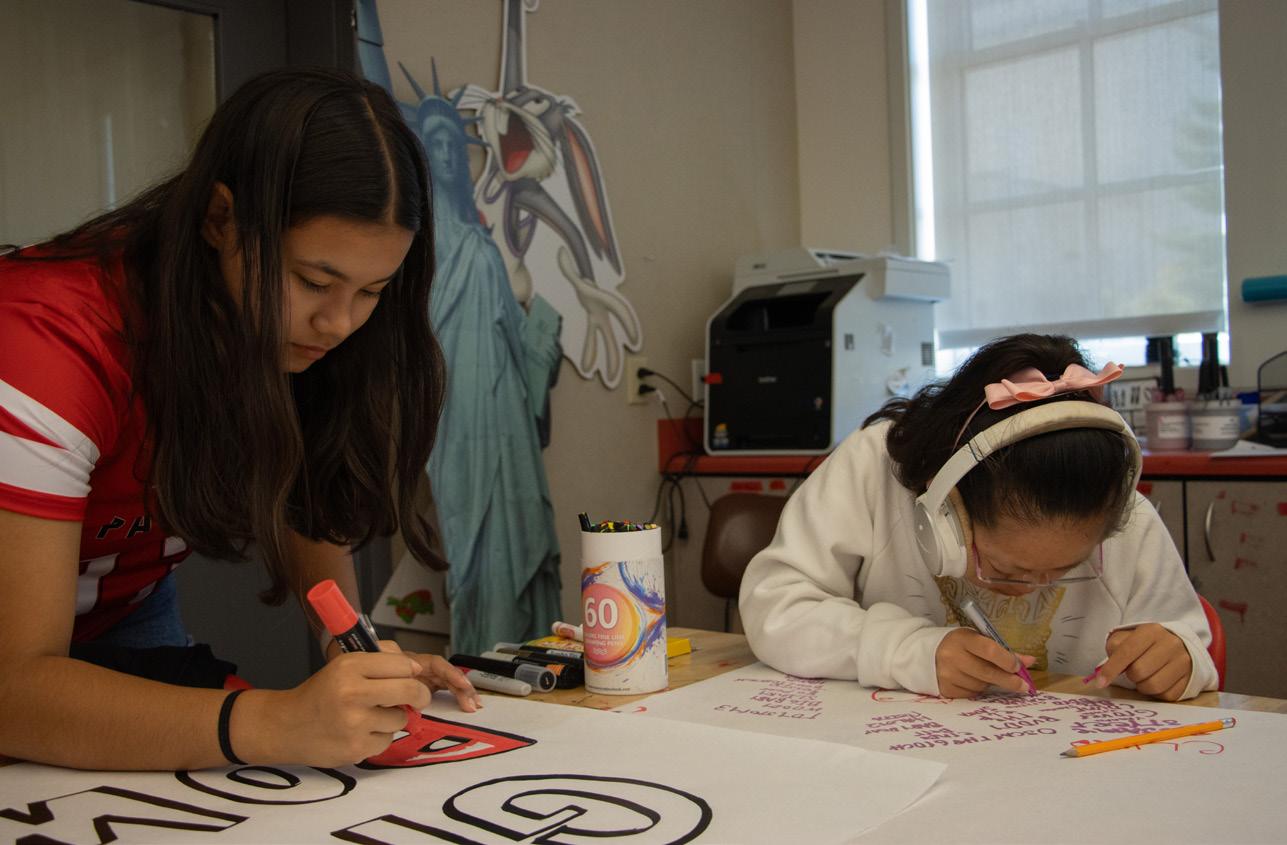
verse perspectives to the leadership class.
“My favorite part is just having new perspectives and getting to hear new information from students that we wouldn’t normally,” Browdy said. “It’s interesting to … [have] them bring that experience into leadership.”
According to Bay Academy teacher Patrick Myers, Principal Jen Fong was instrumental in coordinating the department changes and equipment orders to prepare for the increased number of students. She said that class integration has also helped all students recognize the diverse makeup of the student body.
“Having [Bay Academy] students finding ways for meaningful interaction for everyone in our community, such as through leadership, is really important,” Fong said. “It was great to have the Bay Academy at the rally … so that was important. It’s really valuable for each of us to see the di-
versity within our community.”
So far, Myers said he appreciates other students who have actively included the Bay Academy students.
“I appreciate all the students here, embracing our students in our classes,” Myers said. “Everybody has a lot going on. [Even with] that amount of pressure [everyone] is on, to also embrace our students, it really means a lot.”
Myers believes the leadership class has helped many Bay Academy students learn valuable skills while contributing to school spirit.
“They’re proud of being in the class, like they’re a part of leadership and that community,” Myers said. “It’s only been a couple weeks so far, but I’m noticing them taking a little more ownership of their day, and they’re so excited about it. We have a check-in [every day] asking ‘What are you excited about today?’ [and] when there’s leadership it’s always leadership.”
BY ALEX BERTELLI Senior Reporter
At the end of last year, the administration issued a newsletter outlining two prospective technology policies for implementation in August. They require students to use school-issued Chromebooks and place their phones into pouches during class.
While the Chromebook policy sparked initial backlash from many students, Principal Jen Fong said it was designed to help students stay productive and minimize distractions. During a Curriculum Council meeting last spring, department chairs agreed personal technology diverts students’ attention from coursework.
“The phone policy is excellent, [and] I’m…on the same boat about the laptop policy,” Advanced Placement (AP) Chemistry teacher Josh-
HUYSMANS

as much done during a period and be twice as prepared for quizzes [and] tests than we were in the past.”
AP English Language and Com position teacher Tim Larkin has used phone pouches for almost two years, and emphasizes the comput er policy’s ability to promote more equitable learning environments.
“[The Chromebook policy] serves [several] different purposes. There’s an issue of access and eq uitability in terms of computers,” Larkin said. “Leveling the playing field makes the education experience much more equitable in terms of ac cess to technology.”
Many students, however, have voiced concerns about the Chrome books’ slow startup time and laggy software. Additionally, some extra curriculars require software that Chromebooks can’t run, leading many students to carry both devices to school.

Junior and Iron Panthers robotics co-captain Serena Koopmans believes the computer policy hinders productivity.
“By not having access to our communication software during the day, it’s really difficult for me … to communicate with people about events
I’m coordinating,” Koopmans said. “From the robotics perspective, we


grammers who can’t code on the Chromebooks. Many on [us] have to [carry] a separate laptop.”
Nevertheless, inconvenience is the price paid for catchall solutions.
“I know not everybody’s happy about the Chromebook-only policy … but ultimately … I think it will save us time and make things a little bit more consistent across the board,” Dyl said.
BY ABBY KNIGHT Social Media Manager
Take a look inside A102 and you’ll find students writing something different than standard English essays. This August, English 3 and Advanced Placement English Language and Composition teacher Shane Karshan introduced a new elective: creative writing. The elective, available to upperclassmen, takes place during the fall semester and provides students the opportunity to
engage in a variety of writing activities, including developing characters, flash fiction, poetry, and more.
Writing runs in Karshan’s blood. He was raised in a house hold centered around creativi ty, as his father was a published fine arts author. He became a role model, which Karshan said contributed to his lifelong love for creative writing.

“Growing up, I was fascinated with writing, kind of because he was, and creativity, because he wrote ab-
class], but I think with the kind of onset of AI, to me that makes me want to teach a class like this more,” Karshan said. “I would love to give students the
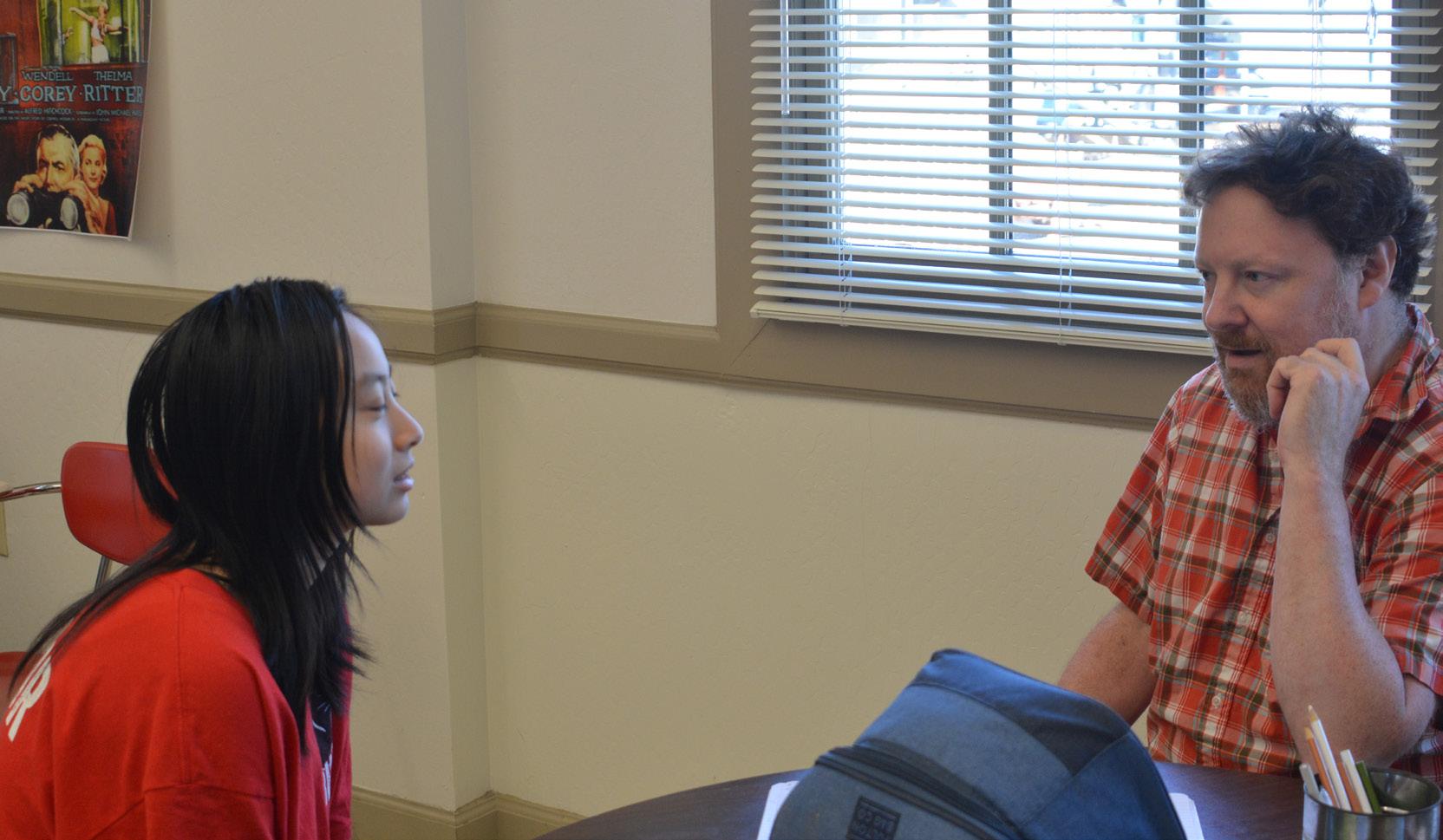


Creative writing student junior TJ Serefiddin said that they’re not worried about AI posing a huge threat to creative writing.
“I feel like AI specifically, while [it’s] an issue definitely for more specific academic writing, it’s not as much of an issue for creative writing, since AI doesn’t understand creativity whatsoever, and also it’s feeding into itself,” Serefiddin said.
Creative writing student senior Jazmin Jajeh has been interested in creative writing since second grade.
“I just really like writing and having a whole class period will be really cool, just to write,” Jajeh said.
Each class begins with a warm-up, ranging from creating Olympic sports to brainstorming a list of things they would never do. Students then engage in both independent and colla-
fictional pieces. For instance, the first assignment of the year was to write a flash fiction story, where students had to produce a short story based on a chosen prompt.
After finishing a story, students check in with their assigned writing groups, where they receive feedback from their peers. Then, Karshan holds one-on-one meetings to debrief students’ pieces.
Karshan hopes the class will benefit students’ academic writing in other subjects and allow them to establish or build on a passion for creative writing.
“I hope students either reconnect with a love of writing that might have dissipated as they got older, or established more of a connection with writing, because to me, it’s empowering to look at writing as an opportunity as opposed to a burden,” Karshan said.
BY KAYLEE HWANG Social Coordinator
Hectic. Stressful. Annoying.
These are just a few words students use to describe the SAT process. While taking the SAT has always been a stressful milestone for college admissions, the COVID-19 pandemic-driven closure of local testing centers has pushed students to go to greater lengths to find an available testing center.
When registration for the August SAT opened in early spring, Bay Area spots — across 12 testing sites — filled up almost immediately, leaving students like senior Anna Durfee scrambling for alternatives. With no test center availability within a 200-mile radius, Durfee flew to San Diego to take the test.
“The test was on Saturday, so me and my twin brother flew down with our dad on Friday night, then took the test and came home Saturday night,” Durfee said.
Senior Kate Adams, one of many students affected by the limited availability of seats, shared her frustration about the lack of local options.
“I think there needs to be
more centers for SATs to be taken. Because it’s ridiculous that I signed up for [my SAT] at the end of June [for the October test], and there were no spots left near me,” Adams said. “I have to go all the way to San Diego.”
According to a College Board press release in 2021, the problem traces back to widespread facility closures during the COVID-19 pandemic. Not only did the pandemic shut down many testing centers across the country, but the limited seats also spurred a national conversation about the equity of standardized testing. The limited seating contributed to many colleges’ reconsideration of SAT’s role in admissions, with some schools adopting test-optional or testblind policies.
College and financial aid advisor Jonathan Dhyne said these closures have only worsened accessibility.
“Not everyone can afford to hop on a plane or stay in a hotel room,” Dhyne said. “We appreciate that local California public schools are trying to level the playing field [since the University of California schools are test-blind], but the accessibility problem is real.”
For senior Reiter Madden, traveling to Southern California to take the SAT has almost
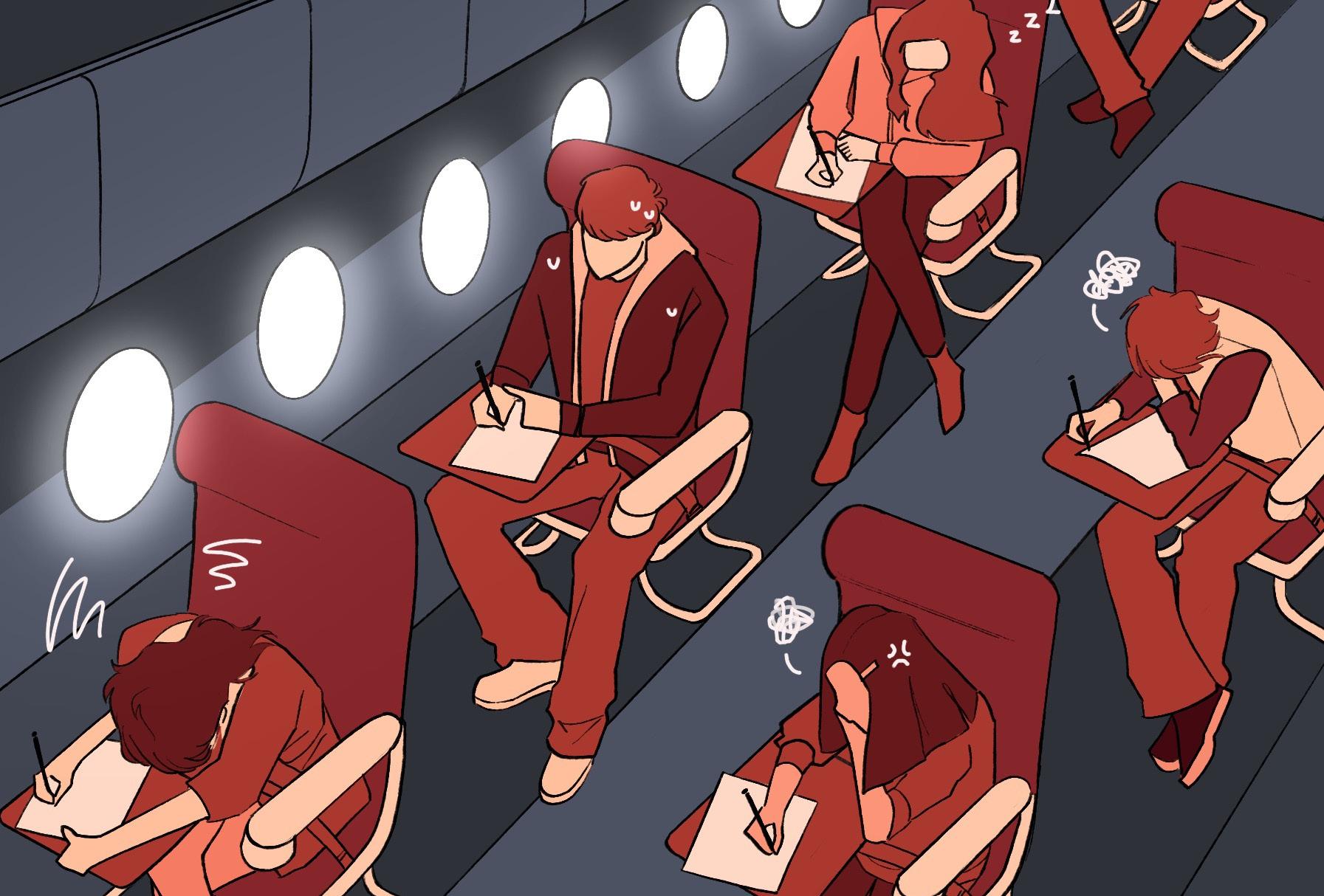
Students face added pressure in the already stressful SAT testing process, due to a shortage of nearby testing centers.
become routine. Madden flew to La Cañada High School in Pasadena in June, and again to Valencia High School in Placentia in August.
“It’s really annoying because I want to take the test, but it’s hard because of the plane ticket cost or gas money,” Madden said.
Durfee also echoes this sentiment.
“Being forced into traveling for [the SAT] is not fair to students who either can’t afford a
plane ticket or just don’t have the time,” Durfee said. “The system is already unfair, and this just makes it worse.”
According to Lasherica Thornton from EdSource — a California newsroom focused on education — the College Board expanded 3000 additional seats and seven new locations in California this past year to accommodate more spots after hearing complaints from students and parents. However, the competition to
secure a spot still lingers.
To help ease the strain, the San Mateo Union High School District is offering an on-site October SAT for seniors, and the PSAT exams for sophomores and juniors.
Dhyne encourages students to reconsider their hyper-focus on the test.
“I encourage students to think outside the box and know that there are options beyond the Ivy League,” Dhyne said.
Tiffany Spohrer


BY PAIGE CORNELIUS Staff Reporter
Subject: Precalculus, Algebra 1
Years teaching: 15
Fun Facts: Likes to box in free time, taught at Peninsula, studied physics and math with a minor in english
Subject: Bay Academy
Years teaching: 4
Fun Facts: Born in Honduras and moved to Bay Area, enjoys hanging out with friends and playing Dungeons and Dragons
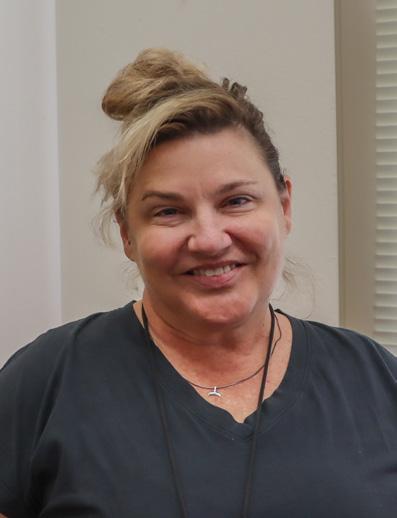
BY AKIRA NAKAMURA Staff Reporter

BY OLIVIA NEWMAN Staff Reporter
Subject: Counseling
Years counseling: 4
Fun Facts: Used to teach math, PE, art, and health, taught in Vietnam and Laos, enjoys scuba diving and underwater photography
Subject: English 1, English Language Development 3, Community Literacy in Action 2
Years teaching: 30
Fun Facts: Likes surfing, spending time with family
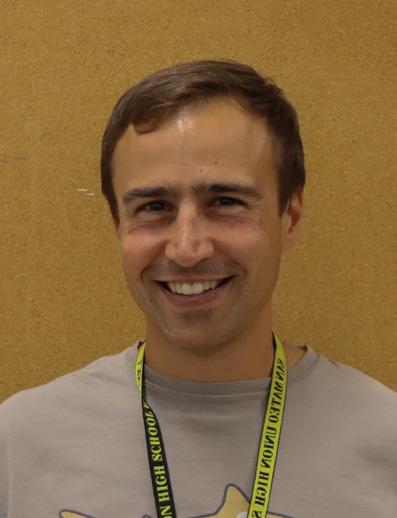
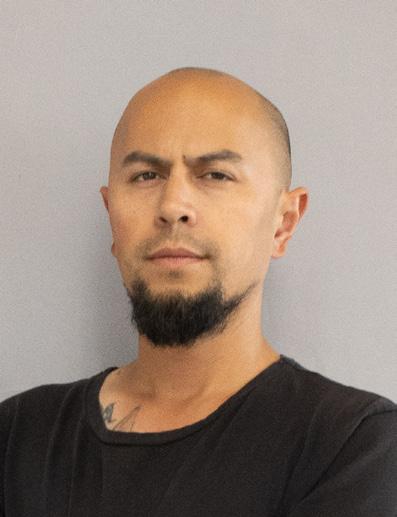

BY AKIRA NAKAMURA Staff Reporter
Subject: Ceramics, Digital Photography
Years teaching: 11
Fun Facts: German and Filipino, enjoys going to arcades and playing vintage games, avid Pokemon fan
Subject: United States History, Ethnic Studies
Years teaching: 1
Fun Facts: Taught english and history in Spain for a year, enjoys crossfit and being active outside of school

BY CHIARA WESLEY Staff Reporter

BY CONNOR LEONG Staff Reporter
Subject: Geometry Years teaching: 2.5
Fun Facts: Likes hockey and spending time outdoors, former environmental journalist and freelance novel writer
BY OLIVIA NEWMAN Staff Reporter
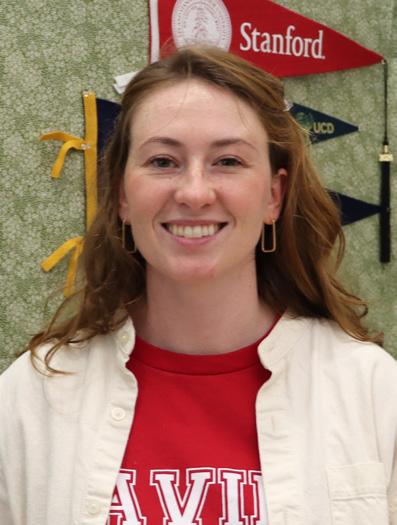
BY PAIGE CORNELIUS Staff Reporter
Subject: Math in the Special Education Department
Years teaching: 10
Fun Facts: Loves motorcycling and being outside with his dog, taught at San Mateo
BY KAI SHAH Staff Reporter
Subject: English 2 Years teaching: 2
Fun Facts: Grew up in Woodside, enjoys surfing and yoga outside of class, attended Stanford
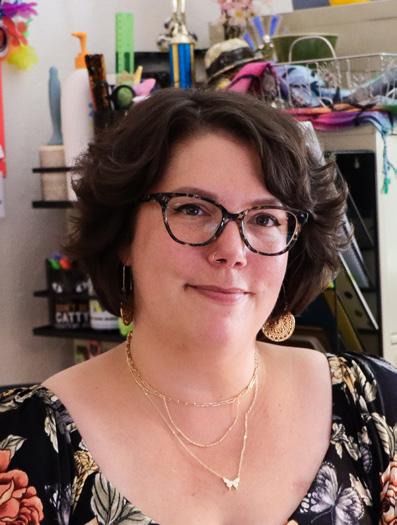

BY ABBY ZARAHN Staff Reporter
Subject: English, Biology Years teaching: 9
Fun Facts: Loves hiking in Pacifica with dog (Cholula) and watching new movies with dog and cat (Ruby)
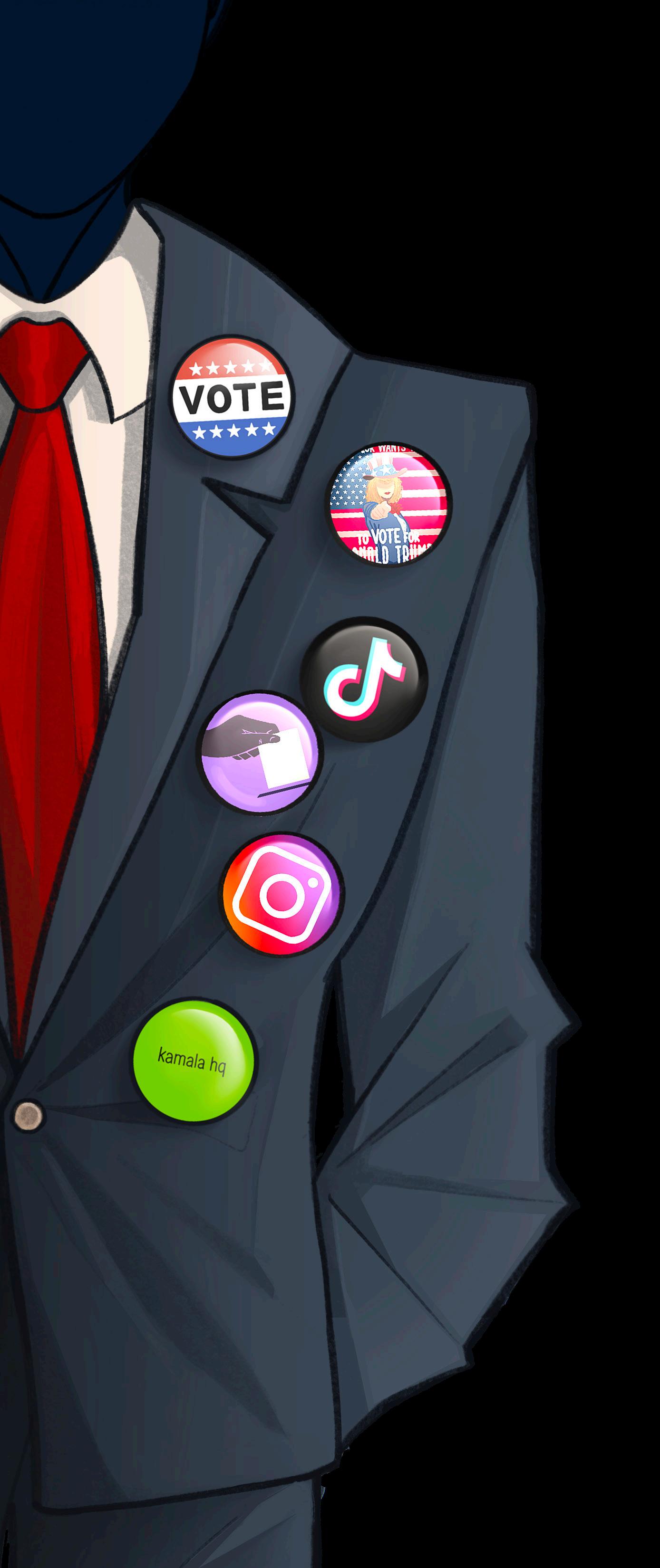

BY HENRY GARDNER Head Photographer
BY JOSEPHINE WETTAN Copy Editor
BY EMMA YU Senior Reporter
The 2024 Presidential Election is less than two months away, and it’s become increasingly clear that young voters will be a crucial demographic in this year’s electorate. According to CIRCLE, a research organization based at Tufts University, over 27% of eligible voters aged 18 to 29 turned out for the midterms in 2022, marking the second-highest youth turnout in nearly three decades. Both candidates have utilized social media and celebrity endorsements to attempt to gain the support of young voters, with Harris’ ‘KamalaHQ’ account, and Trump’s ‘Team Trump’ account both gaining millions of views. With AI also becoming more prevalent in recent years, youth voters have a lot to consider with the election just weeks away.
With 40.8 million members of Gen Z now eligible to vote — including 8.3 million newly eligible since the 2022 midterms — the young generation is poised to make a huge impact on this year’s election. Since 90 percent of voter-age members of Gen Z use social media, they are likely to be receptive to political candidates with a strong presence on their favorite platforms, making online engagement a key strategy to win the ballot.
This year’s voters face an obstacle that hadn’t impacted politics until now — artificial intelligence (AI). Hundreds of “deepfakes,” or AI-generated content, have filtered into the algorithms of popular social media platforms including TikTok, X, and Instagram — and some even feature politicians.
In recent months, bizarre AI memes ranging from former president Donald Trump rescuing kittens to portraying Vice President Kamala Harris as the leader of a communist regime have become viral. But unlike previously, some of these memes have spilled out of the online world, becoming topics of discussion for candidates and even working their way into campaign narratives.
However, despite concerns on the fallout of viral AI deepfakes on the election, a report by the Center for Media Engagement at the University of Texas found that AI’s efforts to sway voter decisions had no clear influence on the outcomes.
Although high user engagement on AI-generated content hasn’t seen a measurable effect on voter outcomes, it still amplifies false narratives. With the prevalence of more realistic deepfakes, differentiating between the real and fake is becoming more challenging. The increasing potential for AI to spread misinformation accentuates the importance of digital fact-checking.
This prompts the question: Do young, relatively inexperienced voters have what it takes to navigate the deepfakes and pitfalls of the current-age internet? Sophomore Bruce Peters believes that they
do — at least for now.
“I think from a very young age, [Gen Z has] just been instilled with skills to kind of help us navigate the Internet,” Peters said. “I remember even in kindergarten we’d [have] classes like be safe on the internet, and I feel like the majority of our generation is safe.”
But adults have valid concerns about students’ media literacy — according to a Stanford study, 82 percent of teenag ers couldn’t tell the difference between real and fake news. Despite these concerns, Advanced Placement (AP) World History and Government teacher Joshua Gnass believes in students’ ability to navigate the online world safely.
“I think we sometimes think kids are igno rant and foolish and they don’t know how to use things,” Gnass said. “Most stu dents understand that you can’t be lieve everything you’re given on the internet.”
The influence of social media ad vertising will only grow as younger, more internet-literate generations become eligible voters. Online consumers are likely to shape the po litical landscape for years to come.
“This is one of the big elections that [Gen Z] can vote in,” Peters said. “A good amount of Gen Z is starting to get to that age, and especially by the next election, we will all mostly be able to vote. As more people start to [meet] the voting age, I think we’re going to see a lot more advertising on social media.”
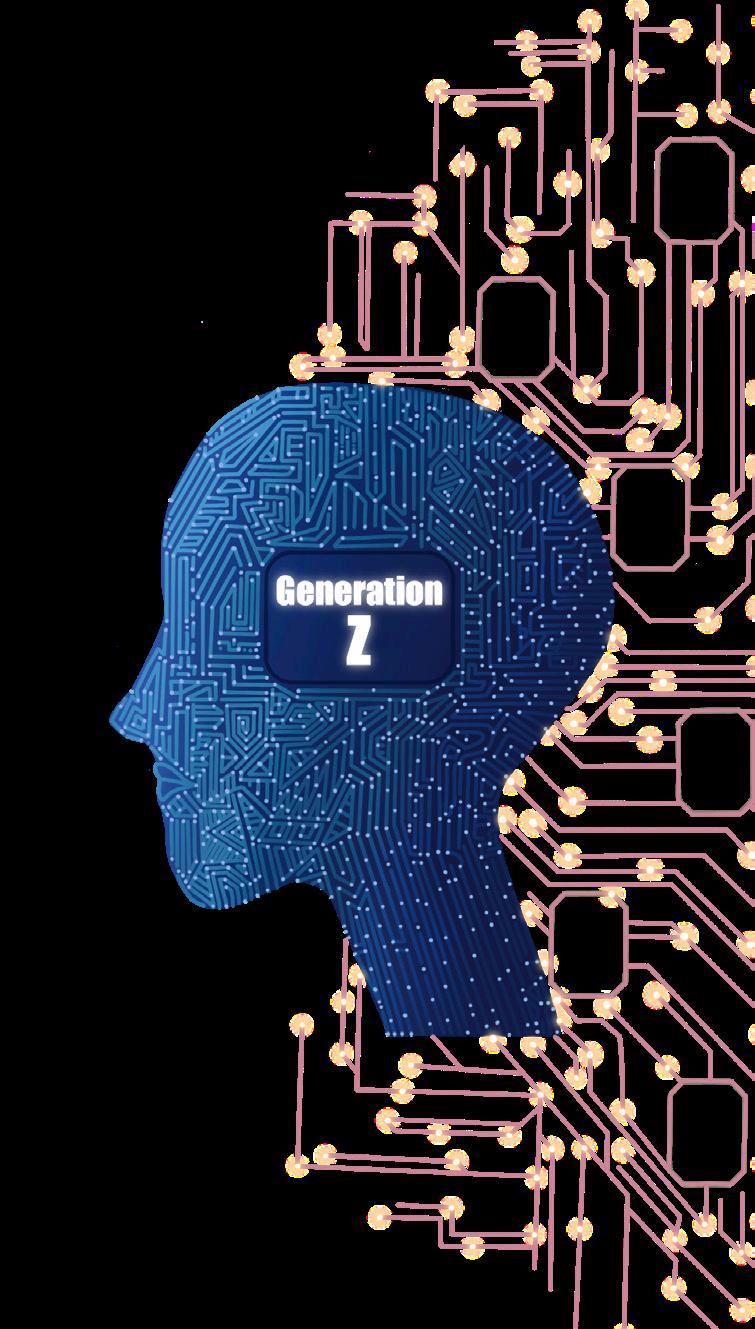
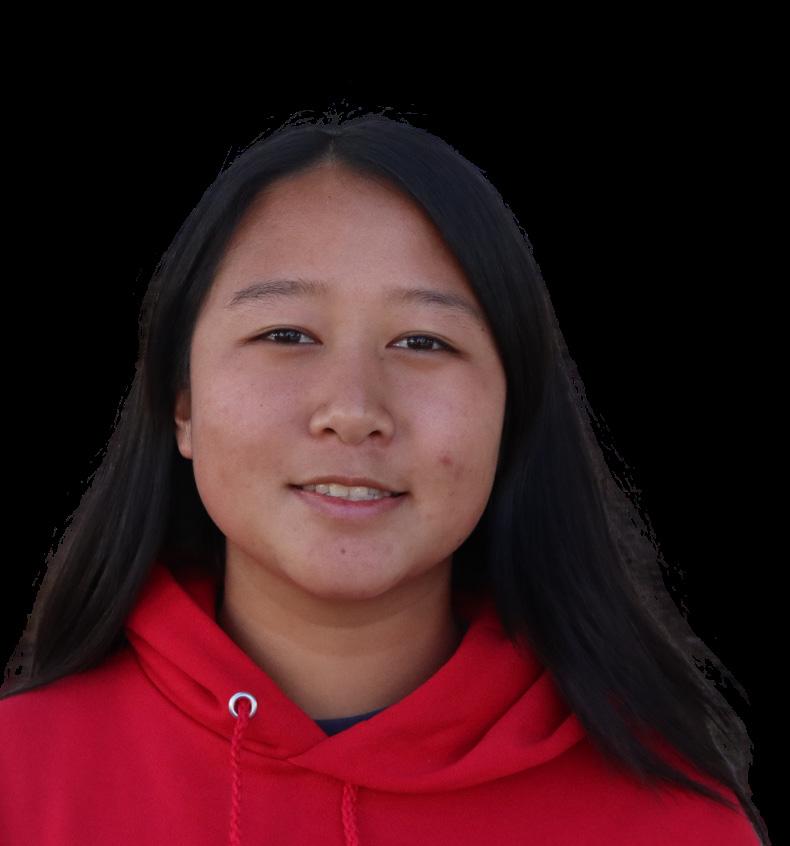
In middle school, junior Lyra Sheng lived and breathed speech and debate. So, naturally, once she arrived at high school, she sought out Model United Nations at the competitive
Now, as the vice president of the club, Sheng believes that Model UN and other political activities provide her with useful tools for a prospective political career, and — even more so — for the rest of her life.
“My involvement in politics-related clubs has strengthened both my media literacy and my understanding of opinions I may not agree with, as well as my empathy for those opinions,” Sheng said. “I believe that allows me to fulfill my role in this democracy more effectively.”
Sheng believes that participating in programs like Model UN equips students with essential tools for success, especially for our younger generation.
“I think the political and media literacy skills that can be gained from [political extracurriculars] are incredibly important to helping us understand how our society functions today,” Sheng said.
Democrats and Republicans alike this year took advantage of star power, leveraging celebrities and social media influencers in an effort to reach the emerging demographic core of American politics — Gen Z voters. With the younger generation’s growing political influence, campaigns are evolving their strategies to capture the attention of a more digitally engaged electorate.
Take Taylor Swift, who lent her voice to the political fray, endorsing Vice President and Democratic nominee Kamala Harris to her 284 million Instagram followers on the night of the presidential debate in Philadelphia on Sept. 10. A year earlier, Swift encouraged her fans to register to vote, directing them to Vote.org. The result was immediate — over 35,000 new voter registrations in a single day, according to Vote.org CEO Andrea Hailey. Harris’ campaign also leaned into Gen Z internet culture. Most notably, the marketing team embraced the viral “brat” meme — the “hot-mess popstar” aesthetic on TikTok — linked to singer Charli XCX. She used the viral sensation as theming for her social media pages, becoming a significant part of her campaign.
Former President and Republican nominee Donald Trump’s campaign also branched out to popular figures among Gen Z voters. TikTok influencer Bryce Hall expressed support for Trump at a Las Vegas rally in September. The Republican National Convention hosted well-known figures like Amber Rose, a rapper and model, and Kid Rock, who performed his 2000 track “American Bad A--” with lyrics altered to include references to the former President.
Advanced Placement Government and Economics teacher Matthew McDermott recognizes how candidates strategically use celebrities to appeal to specific voter demographics.
“Hulkamania [wrestler Hulk
Hogan] at the RNC [Republic National Convention] is tapping into who Trump is hoping supports him, and Kamala, or the Democrats, [are] using the more contemporary celebrities [to] help them,” McDermott said.
As campaigns increasingly turn to celebrities and influencers to connect with Gen Z voters, the broader trend of youth engagement remains a crucial factor in electoral outcomes. McDermott highlights the importance of this connection, noting how youth turnout has historically benefited Democrats.
“Ever since 2008, the narrative has been that when young people vote, Democrats tend to win. So it’s 2024 — 16 years later — but that narrative still applies. If we get this huge turnout that we got in 2008 from younger generations, that seems in part to go well for Democrats,” McDermott said.
Still, it’s hard to quantify how much of an impact celebrity endorsements have on swaying young voters. Senior Shani Roitman, co-president of the Generation Voter Club, believes celebrities and social media influencers won’t change her vote.
“Personally, I wouldn’t let an influencer influence my political beliefs, or who I would vote for. But I think it’s easy for a lot of people in this generation to see an influencer they like pushing [for] something, and then be like, ‘Oh, since this influencer is saying that, then, I believe it,’” Roitman said.
Senior Gigi Sullivan emphasizes the importance of not letting social media solely influence your political decisions.
“I like to look at [politics] when I see something [on social media]. I’m like, ‘Oh, is that actually serious?’ I like to go and look it up and figure out if it’s actually true or not. I look at it for information but you also want to be well informed and not believe everything you see on social media,” Sullivan said.
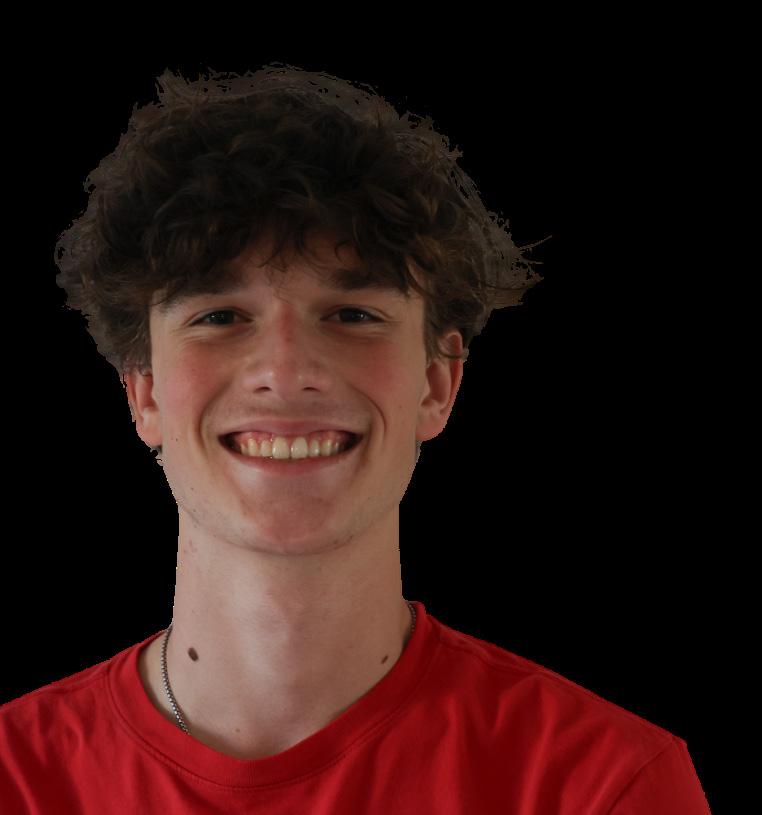
While junior Shai Ring campaigned for Charles Hansen — running candidate for San Mateo City Council (District 2) — this summer to gain experience, his political journey began long before that.
As a freshman, Ring joined programs like Model United Nations and Mock Trial to get involved and stay active in the community. Recently, Ring has expanded his political involvement by working on local and state elections, particularly for Hansen.
“I did some volunteer work to help [Hansen] win the city council election,” Ring said. “The other thing I’m doing is working at the election polls this November, which means I’m helping out at the election stations and helping people vote.”
For Ring, political engagement isn’t just a hobby. He sees youth participation as a crucial factor in civic engagement, especially given today’s climate.
“Considering the current political situation, I think it’s important for teenagers to be involved in politics because we are the future of this country,” Ring said. “We all need to have the knowledge to know how to equip our political will to make change throughout the world and our nation.”
BY EMMA YU Senior Reporter
In flag football’s second year at Burlingame, the program is reaching new heights this season — both on and off the field. On the field, the Panthers are dominating. As of Sept. 19, the team is 3-0, with double-digit victories in all three contests against San Mateo and Menlo-Atherton, followed by a 3413 win against Sequoia High School.
But the growth off the field is equally noteworthy. The team has developed camaraderie, building lasting bonds through a common goal: scoring touchdowns and pulling flags. And, of course, in the words of coaches Nicole Carter and Denise Burch: “world domination.”
“The whole team just playing as one and being together [was an improvement],” senior quarterback Miranda Sibley said.
“[We] struggled [with] that a lot last year, because a lot of kids were new to sports in general, so it was hard to kind of get in the rhythm with completely new people. But I would say overall, we’ve definitely gotten a lot better at that. Our team chemistry is very, very strong, and I think that [will] definitely be a positive aspect throughout the season.”
The players have also improved their catching, tenacity, defensive stability, and understanding of the sport’s many nuances. This rapid progress can be attributed to varsity coach Carter’s growth mindset — mistakes are forgivable, but quitting is not.
“To me, the biggest thing is when you make a mistake, and then you have the ability to go back out there and play as if you didn’t. That’s the most important part for growth,” Carter said. “Last year, some of them
really struggled [to regain focus], and this time, they gathered themselves and then went back out and played cool.”
Flag football hasn’t just caught the attention of the Burlingame community. Nationwide, it has grown into a sensation — a movement, even — among sports enthusiasts and advocates for gender equality in sports. After all, flag football allows players to build strength, sportsmanship, and resilience.
For years, flag football was a male-dominated sport. According to the National Federation of High Schools, which writes and organizes high school athletic rules, womens’ flag football participation has increased 63 percent in the past five years. This dramatic surge in involvement has caused the sport to skyrocket into one of the fastest-growing in the United States.
The evolution of Burlin-
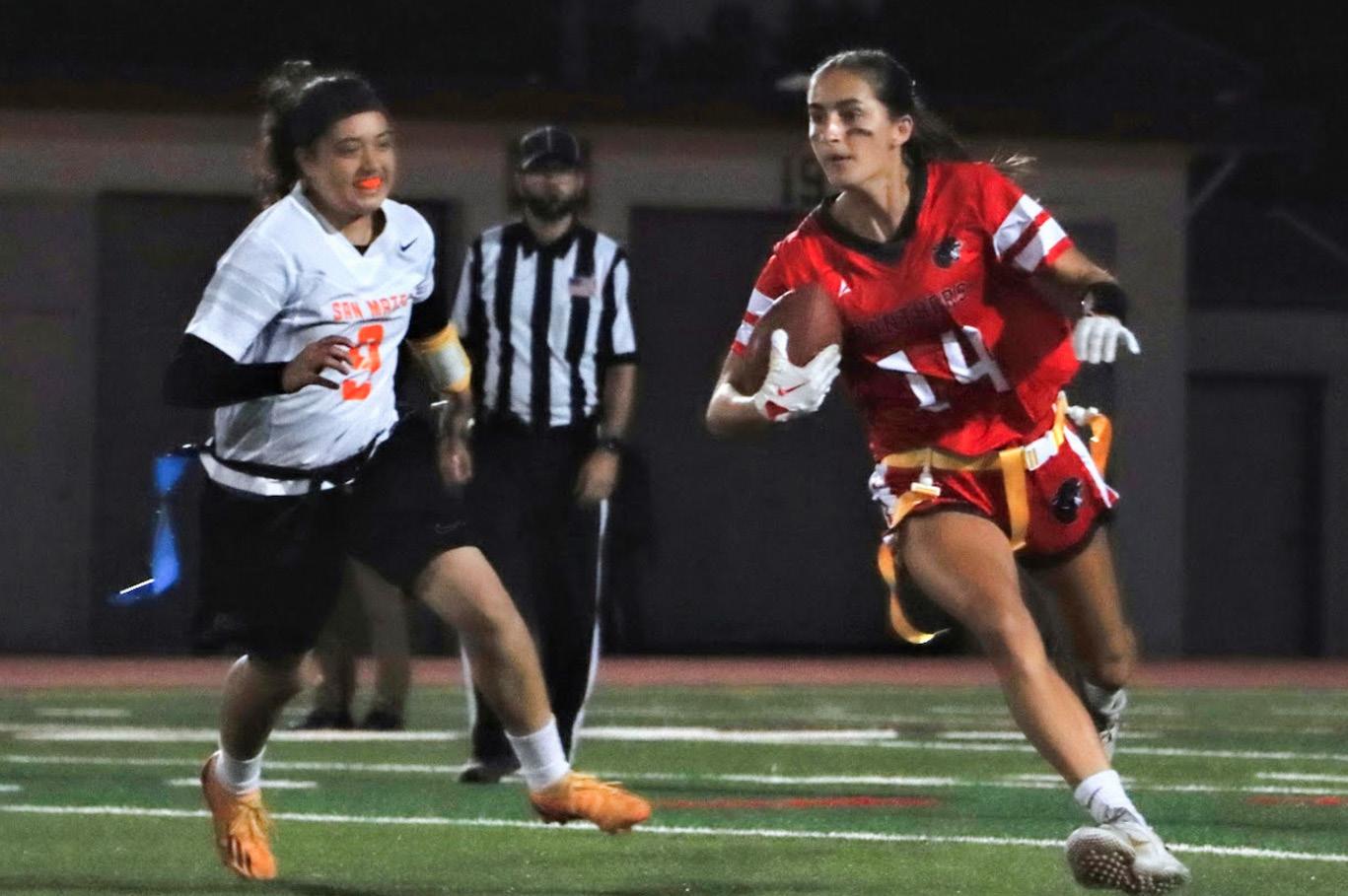
game’s flag football program reflects the national trend. In its second year as a California Interscholastic Federation statewide sanctioned sport, the program added a 16-player junior varsity team, coached by Burch, to accommodate the over 50 girls who tried out in August.
Sibley hopes the Panthers’
success on the field will continue to encourage more girls to get involved in flag football.
“Coming out on top, hopefully, will improve some people’s mindset on flag football, and make them realize that we take the sport seriously, and they should too,” Sibley said.

BY NATALIE GYDE Multimedia Editor
While diving is infamous at the Olympics, the sport often goes unnoticed in high school athletics. Like any other athlete, competitive divers pour hours into their sport, perfecting their intricate flips to prepare for meets. Senior Jack Handelman and sophomore Ella Berger — two student-athletes practicing at the Stanford Diving Club — are no strangers to the intense training and commitment required to compete.
“[In the school year] we practice six days a week. We have two-hour training sessions, one hour on dry land, and one hour in the pool. It’s not all in the pool. Then during the summer, it’s five days a week for six hours a day,” Handelman said.
Due to the lack of nearby diving facilities and practically non-existent high school teams, competitive diving has become increasingly difficult.
“The commitment is a lot, especially because we live here [in Burlingame] and [the club is] at Stanford. I’m so happy to be at Stanford, because it’s such an amazing facility, but it’s an hour [round-trip] drive for a two-hour practice,” Berger said.
But diving is more than just a physical challenge. Overcoming the nerves, trusting
oneself to commit to a dive, and staying poised under pressure are essential elements that lead to success.
“For diving, it’s really hard to not let one dive affect the next, because if you do a really bad dive, the next one could be the best one of your life. You have to blindly trust that
it’s the next one’s going to work out,” Handelman said.
Even though Berger has two years of experience, beginning to dive in eighth grade, she still works hard to keep her composure during competition. According to Berger, if athletes cannot handle their nerves right before

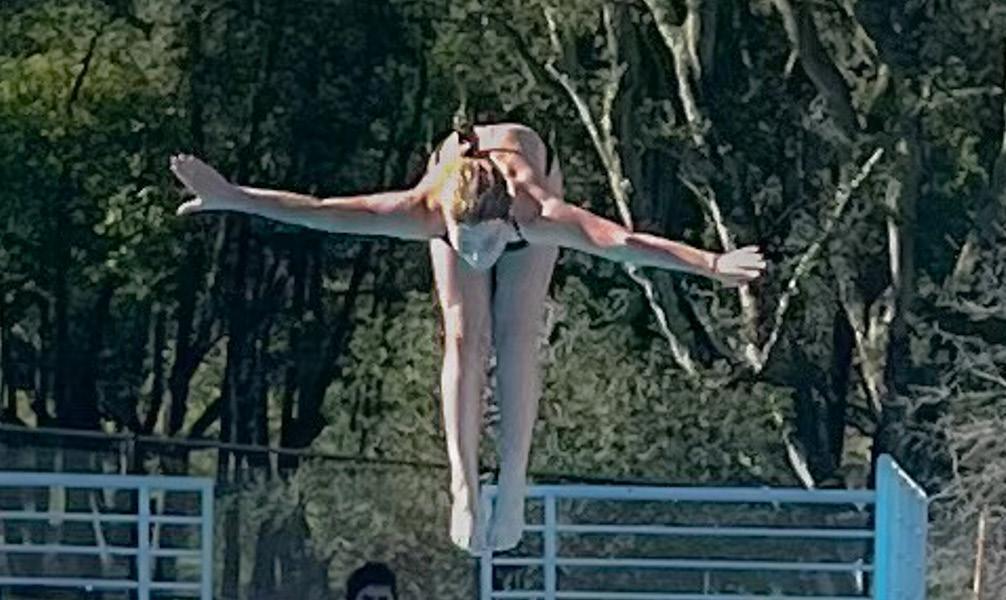
a dive, it becomes difficult to stay focused.
“[Through diving] I’ve learned what stresses me out the most, and that I need to just take a second to calm down. Standing up on those high platforms and doing the dives, you have to take a breath and recollect yourself. I think I’ve learned how to focus more,” Berger said.
The process of executing a dive is complicated. Not only are athletes expected to perform flawlessly, but they have to master fundamentals such as strength and flexibility.
“I think I know what I need to work on in terms of my individual skills. It’s definitely a mindset sport,” Handelman said. “It’s like golf; physically, you could do it. [Mentally], there’s so much technique and I know that I need to work on certain things, those are my goals.”
Over the summer, Handelman qualified for USA Diving Jr. Nationals by placing in the top 10 at Regionals, an event open to anyone. At the event, Handelman noticed the distinctive skill sets of each diver.
“[At nationals], I learned how good our coach is. You see every coach there, and you see how different coaches have different teaching styles. But it doesn’t matter how you do [because] he’s always supporting us and giving us affirmations,” Handelman said.
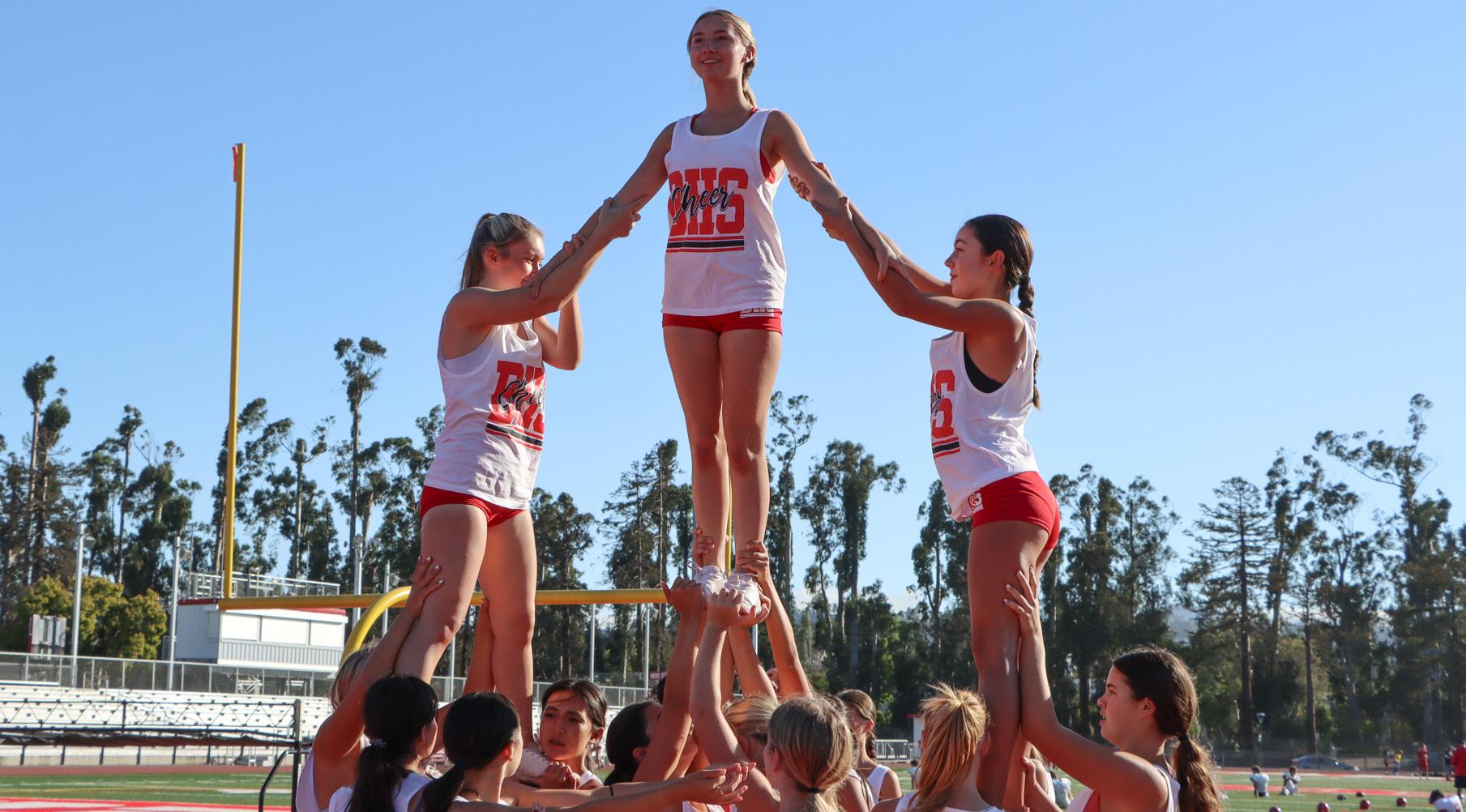
BY INY LI Business Manager
New varsity cheer coach Kayla Clark is determined to start the year strong by strategically assessing the team’s skill set by practicing their halftime routines to ensure perfection. Throughout summer break, the varsity captains introduced the junior varsity (JV) cheer squad to stunts and cheers, while the varsity squad regularly weight-trained to stay active.
After intense preparation, the squad had one stunt and two dance sequences, made by senior captains Sofia Crosina, Annie Conway, Jasmine Pineda, and Jordyn Nawrocki at the first home football game on Friday, Sept. 6 against Terra Nova High School.
While the squad experienced difficulties during practice, Crosina believed the performance was a success.
“At practice, it was a little difficult because we were having a hard time hitting the stunts perfectly and were stressed out about how our performance was going to go,”
Crosina said. “But we ended up going out there and putting out our best efforts, and it ended up going great. Everything hit, all the stunts went really well, and I think it was a really good first home game performance.”
The cheerleaders are now focusing on their halftime performance for Little Big Game on Nov. 9, where the captains will create the dances while the coaches coordinate the stunts. Through conditioning and strength training, the JV and varsity teams are now practicing together to find a balance in skill sets.
“After every game, the goal is to build multiple sections of the Little Big Game routine and showcase the most difficult and challenging routine we have during the halftime show of Little Big Game,”
Clark said. “Cheer is a build-asyou-go sport, so we have all season to prepare with multiple mini routines throughout each week, but Little Big Game is really their chance to showcase the most elite stunts they can do.”
Crosina emphasizes the impor-
tance of creating a strong bond between the cheerleaders as their events begin to ramp up.
“There’s been a lot of bad attitude surrounding our team, whether that be mindset or the coaches we’ve had, but this year is a clean slate for everyone,” Crosina said. “We have a new coach again, but I can tell this coach wants the best for us as a team. I want us to be more connected and focused at practice. I want us to be mindful and in the moment of what we’re doing and [work hard] to do great at halftime.”
For Clark, she is thankful for her fellow coaching staff and athletes for the warm welcome as they kick off the season. After seasons of mishaps with constant coaching turnover, Clark is determined to unite the team in both spirit and attitude.
“I’ve just been able to get to know the squad more and more in the [first few] weeks,” Clark said. “There’s a lot of really good talent amongst the team, and all the girls have been working really hard the past few weeks.”
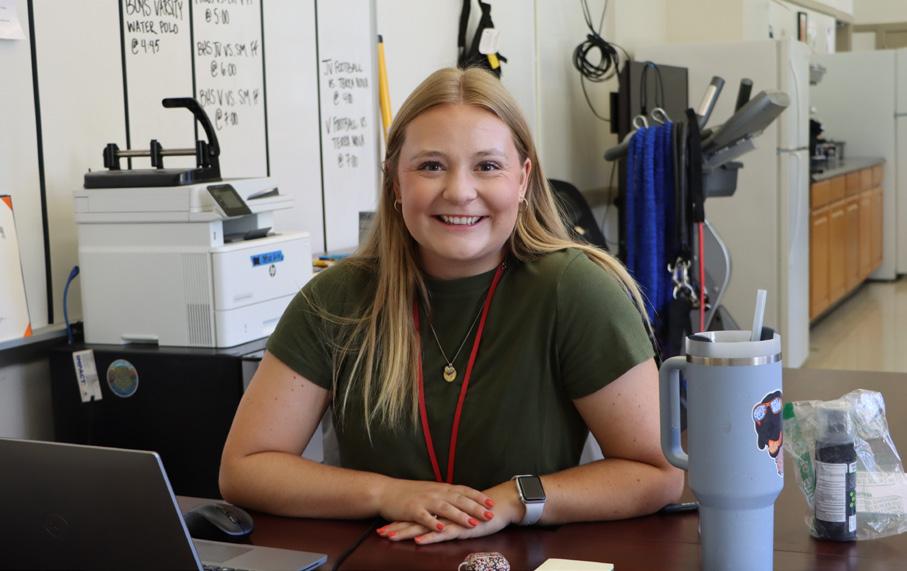
BY AUDREY WEI Senior Reporter
Whether working with collegiate football teams or high schoolers in rural Idaho with limited medical care, new athletic trainer Gillian Rodgers brings her extensive experience to the athletic program.
As a former athlete herself, Rodgers knows firsthand the toll injuries can take. A series of injuries cut her athletic career short, but in the process, opened the door to sports medicine — a field that ignited a passion for helping others stay in the game.
“When I was in high school, I suffered through some pretty serious injuries, including a concussion. I had an amazing athletic trainer and got to talk to him throughout my recovery from those injuries,” Rodgers said. “Once I got to college and started taking classes, there was never a doubt. It was just something I was always interested in.”
Rodgers graduated from Boise State University with a Bachelor’s degree in kinesiology and a Master’s degree in athletic training.
“I worked in many different roles throughout my school experience at the collegiate level, high school level, and professional level of athletics,” Rodgers said. “My family is originally from the Bay Area. I grew up here and left to go out of state for a few years for college, so it was a fun opportunity for me to move back.”
During graduate school in 2022, Rodgers also had the opportunity to work in rural neighborhoods of Idaho with kids who didn’t have access to healthcare or advanced medical supplies.
“A lot of times these kiddos said that that was the first time they never had an interaction with a healthcare provider [and] it showed me the different levels of access that people have to resources,” Rodgers said. “It made me want to reach out to different populations that might not have a full-time athletic trainer or even a regular health care provider.”
As the school’s new athletic trainer, Rodgers hopes to educate more people on the importance of sports medicine and preventing injury.
“I’m just here to make athletics safer so everyone can participate without fear of not receiving appropriate care,” Rodgers said.
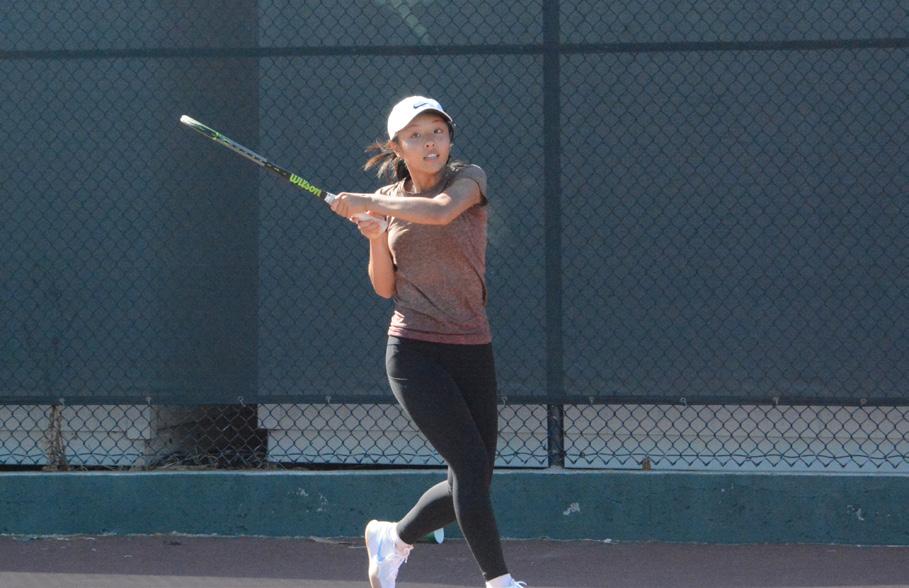
Girls’ varsity tennis is gearing up for a season of growth and development. Under new head coach Doug Stone, the team is prepared to compete in the highly competitive PAL Bay Division.
The squad is off to a strong start, boasting a 2-1 record as of Sept. 18. The Panthers dominated matches against Menlo-Atherton and San Mateo High School.
“As a team, we want to support each other and be the best we can,” Stone said. “Tennis is not easy. When you’re out there, it’s just you on the court. But we’re out here to have fun, develop our game, and enjoy the sport at every level.”
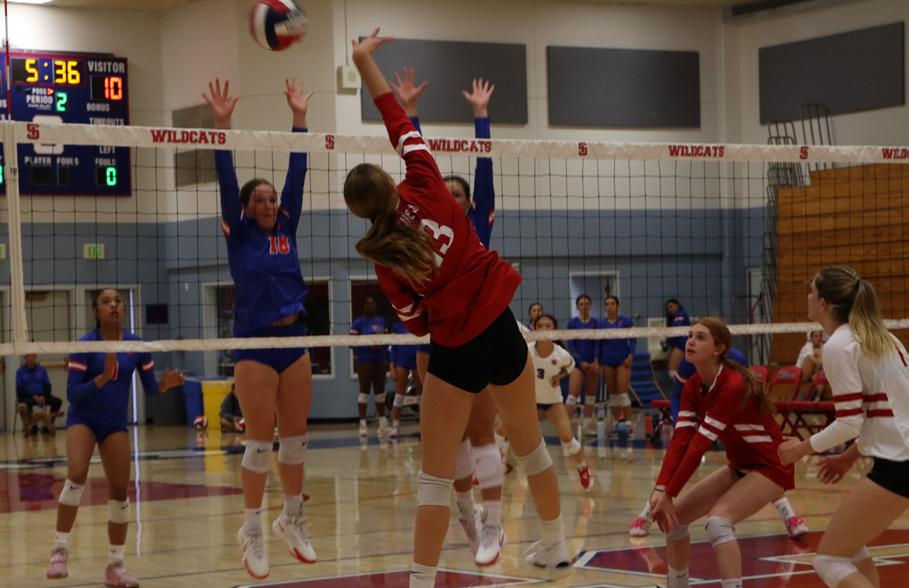
Following their PAL Bay and Central Coast Section (CCS) title, girls’ varsity volleyball looks to repeat that success this season.
“I would love for us to get to repeat as CCS champions, winning [league] is also always a goal and just making sure our players have a positive experience and still love volleyball in November, no matter how the season ends,” head coach Hannah Korslund said.
The Panthers are practicing hard to stay in top form before the playoffs. As of Sept. 18, the team is 3-2 overall, beating league opponents Hillsdale and Carlmont High School.

Boys’ varsity water polo finished last season’s CCS championship in second place, moving into the stronger PAL Bay Division. With essentially the same varsity roster to accompany new coach Brett Reynolds, the team hopes to compete and succeed against more formidable opponents.
“That’s a key teaching point that we want to emphasize this year,” Reynolds said. “It’s not just scoring — it’s all the little things that make a good team.”
As of Sept. 18, the Panthers are 2-1 in league play, with victories against Hillsdale and Aragon High School.
Editor-in-Chief Sophia Bella
Managing Editors
Jeannine Chiang
Zachary Newman
Design Editor Joelle Huysmans
Social Media Manager Abby Knight
Web Editor Connie Lu
Multimedia Editor Natalie Gyde
Business Manager Iny Li
Head Photographer Henry Gardner
Diversity Coordinator Evelyn Du
Social Coordinator Kaylee Hwang
Copy Editors
Will Kriner
Sophia Doss
Josie Wettan
Senior Reporter
Alex Bertelli
Audrey Wei
Emma Yu
Staff Reporters
Paige Cornelius
Connor Leong
Akira Nakamura
Olivia Newman
Kai Shah
Chiara Wesley
Abby Zarahn
Teacher Adviser
Melissa Murphy
Policy Statement:
The Burlingame B is a student-run newspaper with the sole purpose of providing an open forum for student expression. Anything printed represents the opinion of the writer, but not necessarily that of the Burlingame B staff, the administration, or the faculty of Burlingame High School, or anyone affiliated with the San Mateo Union High School District. The Burlingame B does not discriminate against race, political orientation, ethnicity, religion, gender, sexual orientation or disability. Although The Burlingame B will never refuse to publish guest submission based on the aforementioned factors, we reserve the right to edit or not publish them.
Letters to the Editor
Disagree with the writers? Bring your letters to the room A120 or email them to <theburlingameb@smuhsd.org>. Letters may be considered for publication. The Burlingame B reserves the right to edit for clarity, length, and accuracy. We welcome all comments.
Website: www.theburlingameb.org
Phone: (650) 558-2899
Email: theburlingameb@gmail.com
Address: 1 Mangini Way, Burlingame, CA 94010
BY THE BURLINGAME B EDITORIAL BOARD
Today, we are often one click away from accessing an overwhelming amount of information. But of course, with that, comes a critical need for media literacy skills. With a growing habit of mass information consumption, many teenagers struggle to analyze and understand the constant stream of content being pushed out by big platforms. Instead, we often resort to bite-sized snippets of stories that diminish our ability to think critically about the news headlines that we saw? (b/c it’s on tiktok or snap? that we read.
As younger generations are exposed to technology earlier on, they are more likely to rely on social media as a main source of information. As a result, youth don’t feel the need to be informed by reliable sources and are more susceptible to misinformation. A study conducted by the Poynter Institute for Media Studies in 2022 found that almost half of all young adult participants spread misinformation unintentionally, while another third of the subjects impulsively did so.
Social media content is built upon algorithms designed to serve users curated content, creating personalized echo chambers. Through
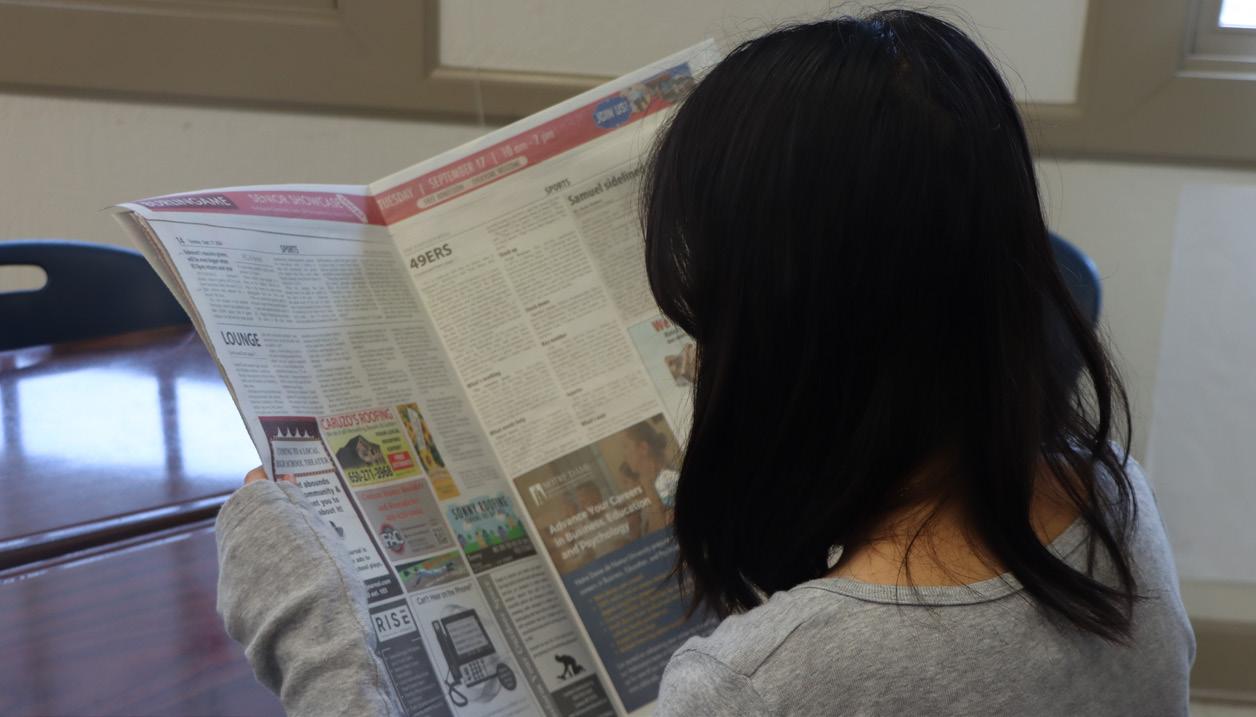
this process, teenagers are often exposed to information they want to see, rather than objective accounts of events. As a result, many young people view the world through a filtered lens, deepening divides over what is considered the truth. This overexposure of news centered around their beliefs causes teenagers to tend to ignore other perspectives.
Because social media typically oversimplifies news for easier comprehension and sensationalization, it omits key details of current events, leaving the user with an incomplete picture. But teenagers can easily combat this daunting task of reading news articles — whether it’s listening to a podcast, recapping daily news, scrolling through news
aggregators like Google or Apple News with a diverse range of topics, or following the social media accounts of an established news source. Modern problems can be solved by modern solutions.
The impact of reading news goes a long way. By becoming more informed, citizens have a chance to hold impactful discussions on societal issues, increase civic engagement, and have more empathy regarding sensitive topics. News is an integral part of society’s inner workings and should be more present in everyday life. Social media may be a shortcut for quick facts, but ultimately, a comprehensive understanding of current events is necessary.
BY KAYLEE HWANG Social Coordinator
No, TikTok isn’t ruining the music industry. It’s helping it grow.
Although overplayed tracks make songs seem “basic,” the app is far from degrading musical quality. As we scroll, we’re exposed to an endless stream of new music to add to our playlists.
Rather than reducing music to mere “soundbites,” TikTok offers opportunities for emerging artists like Sabrina Carpenter and Chappell Roan, who have found themselves in the spotlight largely thanks to TikTok.
According to a study by MRC Data, 67% of the app’s users are more likely to seek out songs on music-streaming services after hearing them on TikTok. TikTok broadens musical tastes, exposing listeners to new genres and styles they might not explore otherwise.
While TikTok’s algorithm prioritizes catchy content, this doesn’t equate to a loss of musical quality. Memorable music has always been a hallmark of pop culture. TikTok simply accelerates the process. It’s not the platform that dictates quality — artists still control their creative vision.
BY HENRY GARDNER Head Photographer
Yes, TikTok has become a platform for artists to explode in popularity. Yes, TikTok is reconstructing the music industry. And yes, TikTok is the way that we’ve discovered some of the biggest songs in the past few years.
However, I still believe that TikTok’s effect on the music industry is catastrophic.
It’s already tough to find people with similar music tastes, but even with music’s subjectivity, many of the songs fueling people’s mindless scrolling are just plain bad.
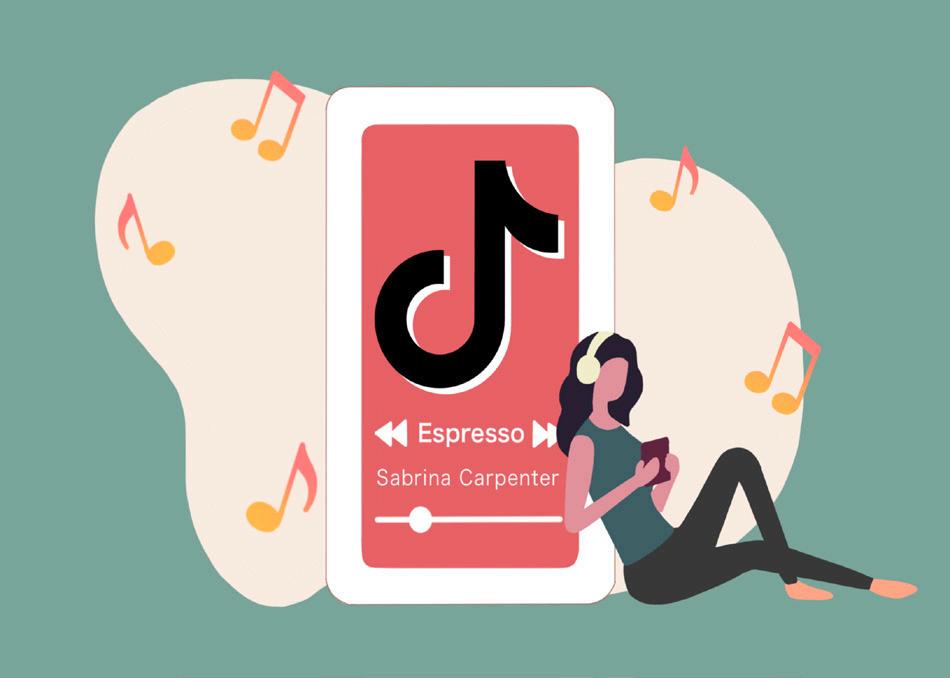
Dismissing popular songs as “low quality” based on personal taste disregards the diversity TikTok offers. TikTok allows niche genres to flourish alongside mainstream hits.
Sure, not every viral song is a masterpiece, but isn’t that true of every era of music? TikTok gives listeners the freedom to decide what resonates with them. Because in the end, it’s up to you—not the platform—to define what good music is.
TikTok’s algorithm prioritizes short bursts of dopamine—not just in bite-sized videos but, also in the audios behind them. Most songs on TikTok don’t blow up because of their quality, but because they fit a certain trend. Artists and labels now focus on creating music that will “blow up” on TikTok, sacrificing true artistry and quality for songs that are overproduced and “catchy.” Songs are also getting shorter in the era of TikTok— half of Spotify’s 2023 hit songs came in under three minutes, according to an article written by Szu Yu Chen of the Washington Post. Even once the song reaches the platform, it continues to be chopped and edited, sped up and slowed down, and altered until the artist’s song is a far cry away from what their original vision was.
I’m fairly confident that when it comes down to it—when you get in the car, sit down to study, or relax in your room—you probably put on some music, and the songs you hear on TikTok are not the ones you play.

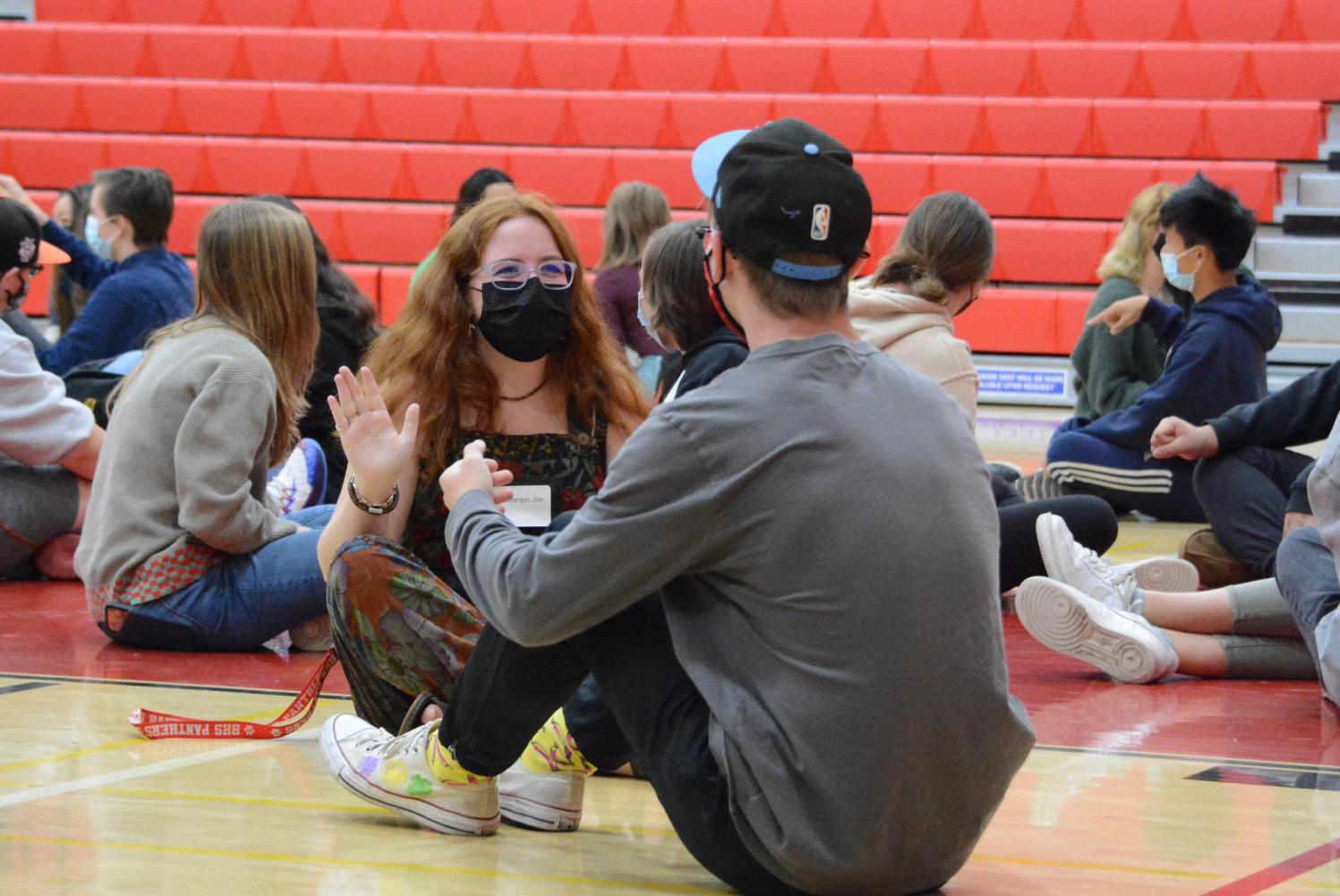
BY CONNIE LU Web Editor
“It’s hard to hate someone whose story you know.”
That’s the main catchphrase — and spirited mantra — of Breaking Down the Walls (BDTW), a community-building program returning to campus from Sept. 23 to 27 at the Burlingame Recreation Center. The initiative, hosted by Ignite 2 Unite, aims to foster connection through shared stories and new perspectives. The six-hour event, mandatory for underclassmen and new upperclassmen, starts with light icebreakers before gradually moving into more personal and vulnerable discussions.
Burlingame first hosted BDTW in the 2019-20 school year and has held it two more times since. After consulting with the Parents Group, which funds the pro-
gram through the Excellence Fund, Principal Jen Fong decided to make BDTW a biennial event to promote inclusion within the school community.
Fong brought the program back in March 2023 after multiple hate incidents, with hopes that BDTW would help students recognize their differences in a meaningful way. While struggles can often be hard to talk about, they can spark moments of empathy and bonding and help students realize that they’re not alone.
For senior Emmett Kliger, the hate on campus was also the reason why he stepped up to be a student leader during the event.
“There was so much hate and bigotry going on on campus that I think our school really needed … a refresher,” Kliger said. “There were swastikas and hateful writing almost every week that year.
So I wanted to be able to be a part of something where I could say ‘You know what, this isn’t who we are as a community [and] campus.’ I think [BDTW] really gave me that opportunity to do so.”
Although instances of hate were not completely eradicated, Kliger believes that BDTW helped bring more awareness to these issues and is a step in the right direction. By allowing people to understand other perspectives, BDTW has also allowed many participants, like senior Edy Knight, to form new friendships and connections.
“[My favorite part was being] able to see how everybody else related to each other, to relate to people you thought you had nothing in common with or connect [with] on a deeper level,” Knight said.
Fong hopes that by structuring the program in smaller groups, students will gain a sense of emotional maturity through deeper conversations.
“In a public setting, like school, people put on a facade,” Fong said. “They pretend [they’re] a totally healthy, happy individual. The reality is, they’re having some struggle at home, and maybe they come to school [as] a distraction. But when you finally open up to your friend, [and] you find out they have the same struggle, a lot of times that is a bonding point for you to have a very strong friendship.”
Additionally, Fong anticipates that including both students and staff will help students see their teachers as not just authority figures, but as human beings they can connect with and talk to.
“I think that this program teaches us to deal with our heart[s] and our caring for each other,” Fong said. “It gives us language for how to speak to each other, how to ask [deeper] questions.”

“I actually made multiple friends I still have to this day, through Breaking Down the Walls. ”
- Edy Knight, senior
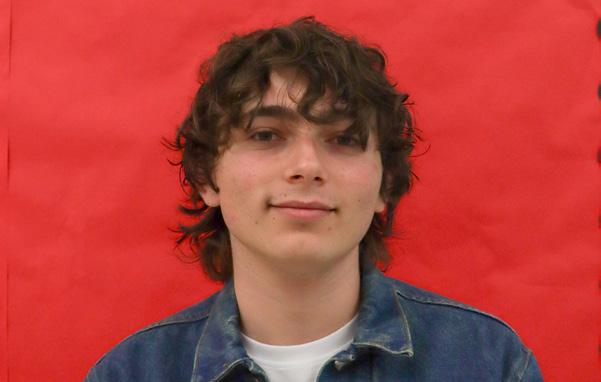
“[It helped me] understand what they’re going through and their story, and take [a] step in their shoes ... [and] see that their life is different than mine.”
- Emmett Kliger, senior
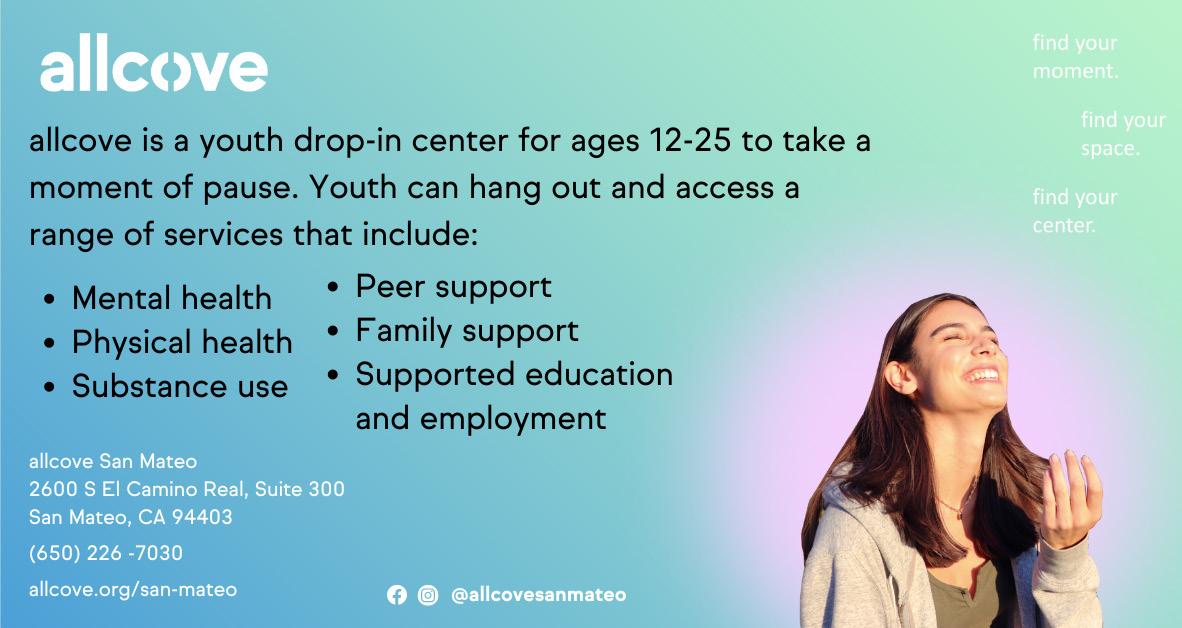
BY AUDREY WEI Senior Reporter
Leadership hosted Minion-themed spirit week from Aug. 26 to Aug. 30 to kick off the school year.
“My commission and I were just really inspired by the movie Despicable Me 4 because it was really popular during the summer,” senior and Rallies and Activities Commission lead Celina Zheng said.
Throughout the week, students and staff dressed up according to the daily theme. Monday was Tropical Day, Tuesday Denim Day, Wednesday Gru and Dru Twin Day, Thursday Goggle Day, and Friday was Class Color Day.
The week culminated with the “Welcome Back Rally,” featuring Minion-inspired activities, including a crowd chant and banana toss. Students also participated in relay races and musical chair competitions.
“I hope [the rally is] something that students can [discuss] in class,” Zheng said. “I feel like this year, people have been more spirited and

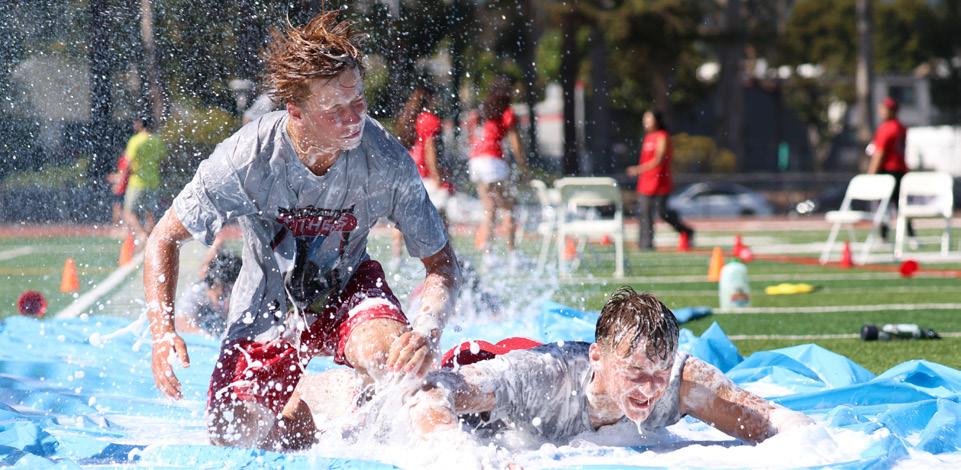
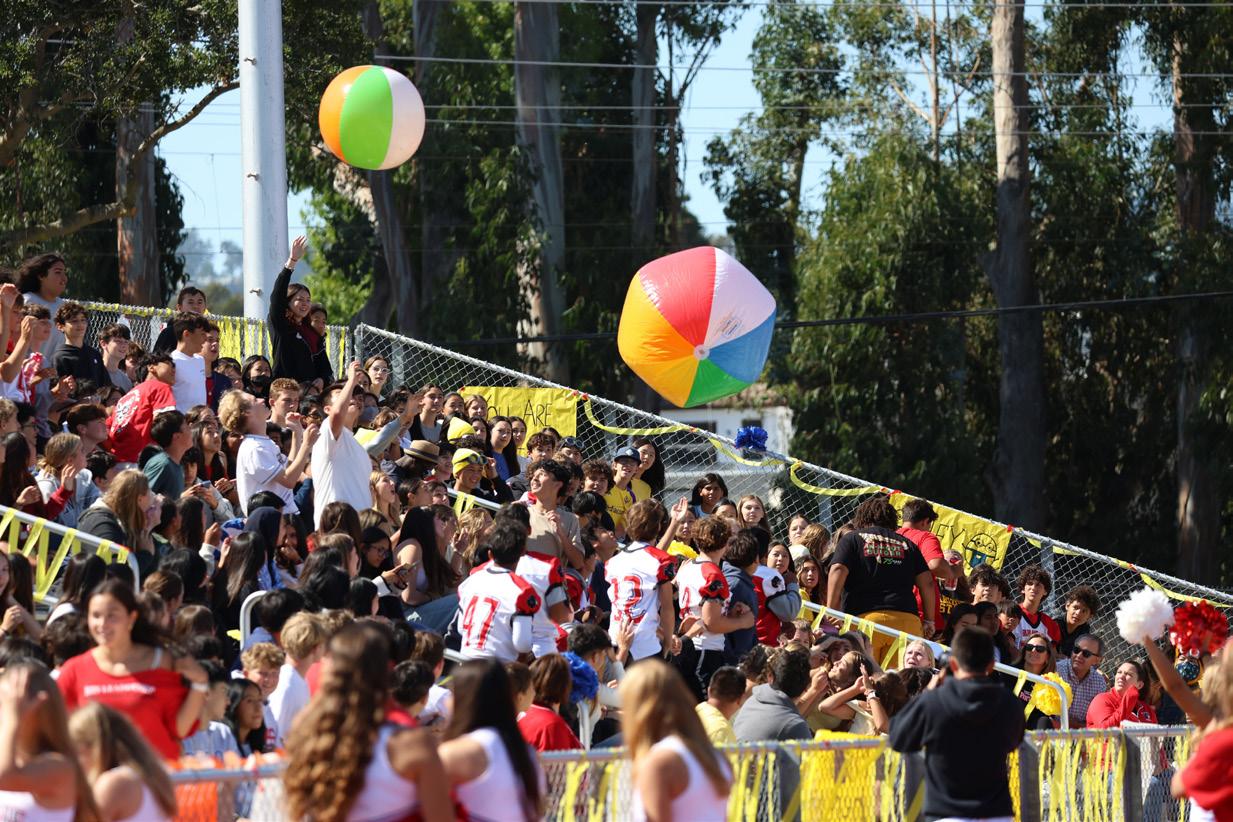
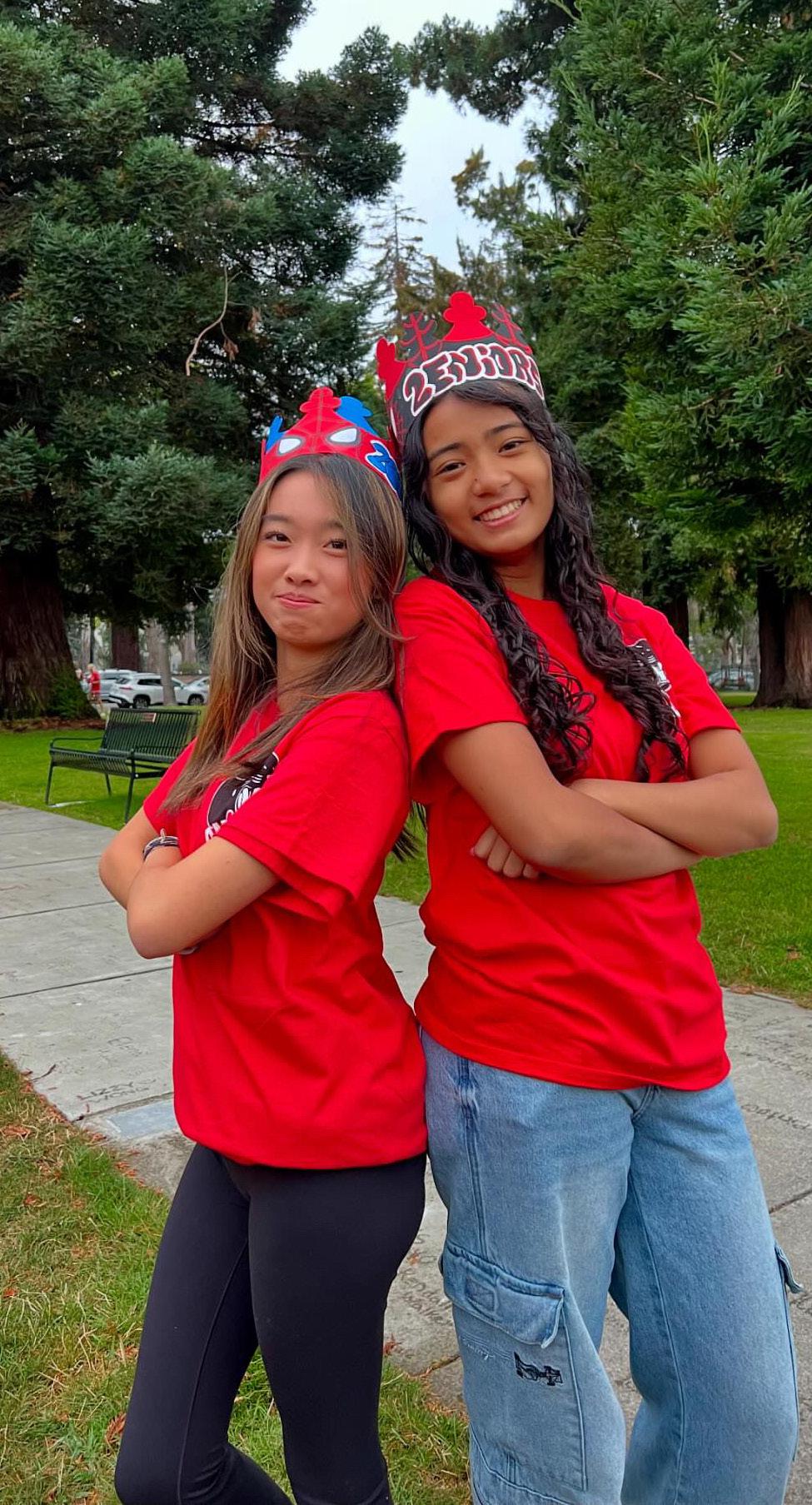


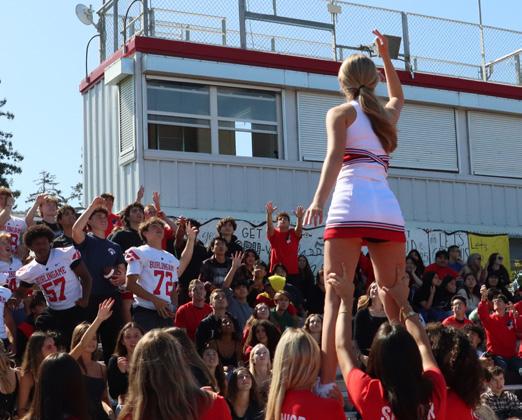

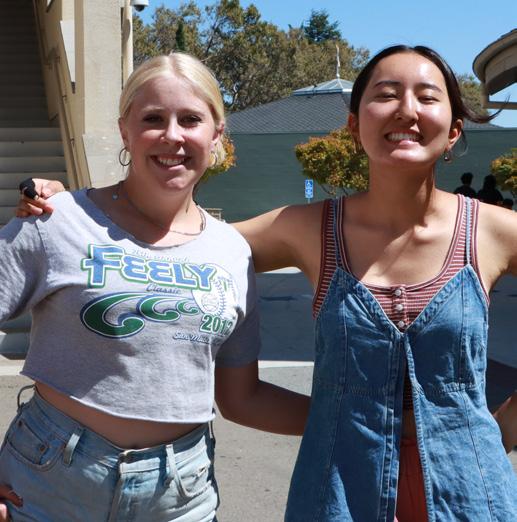
BY NATALIE GYDE Multimedia Editor

School started earlier than normal for the class of 2025 on Friday, Aug. 30. At 6:30 a.m., seniors gathered on the front lawn to participate in senior sunrise — a tradition host

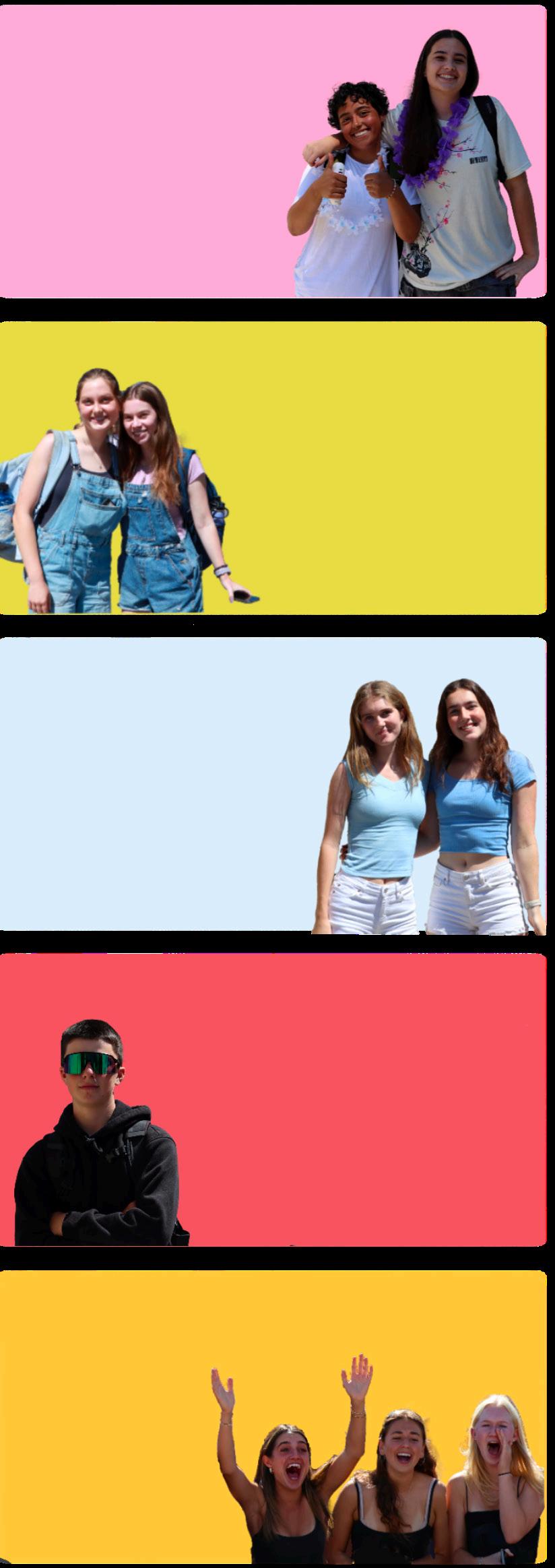
senior class cabinet.
“Having done it for the past three years, it’s always a great event. I think seniors really appreciate having a special event just for them at the beginning of the year. It’s a great bonding experience,” senior class advisor Jennifer Feldis said.
Breakfast tables were filled with pastries — from croissants to chocolate chip muffins — and hot drinks provided by the Parents Group. Set up by the senior class cabinet, students could also be seen playing lawn games such as Spikeball, cornhole, and Connect 4.

“When planning the senior sunrise, we just wanted to make it a fun and memorable event.
So we first started with what kind of foods we should get and what we should have the parent volunteers bring. [...] Then we had the raffle, which was popular last year, so we thought that would be fun again,” senior class president Lexie Levitt said.
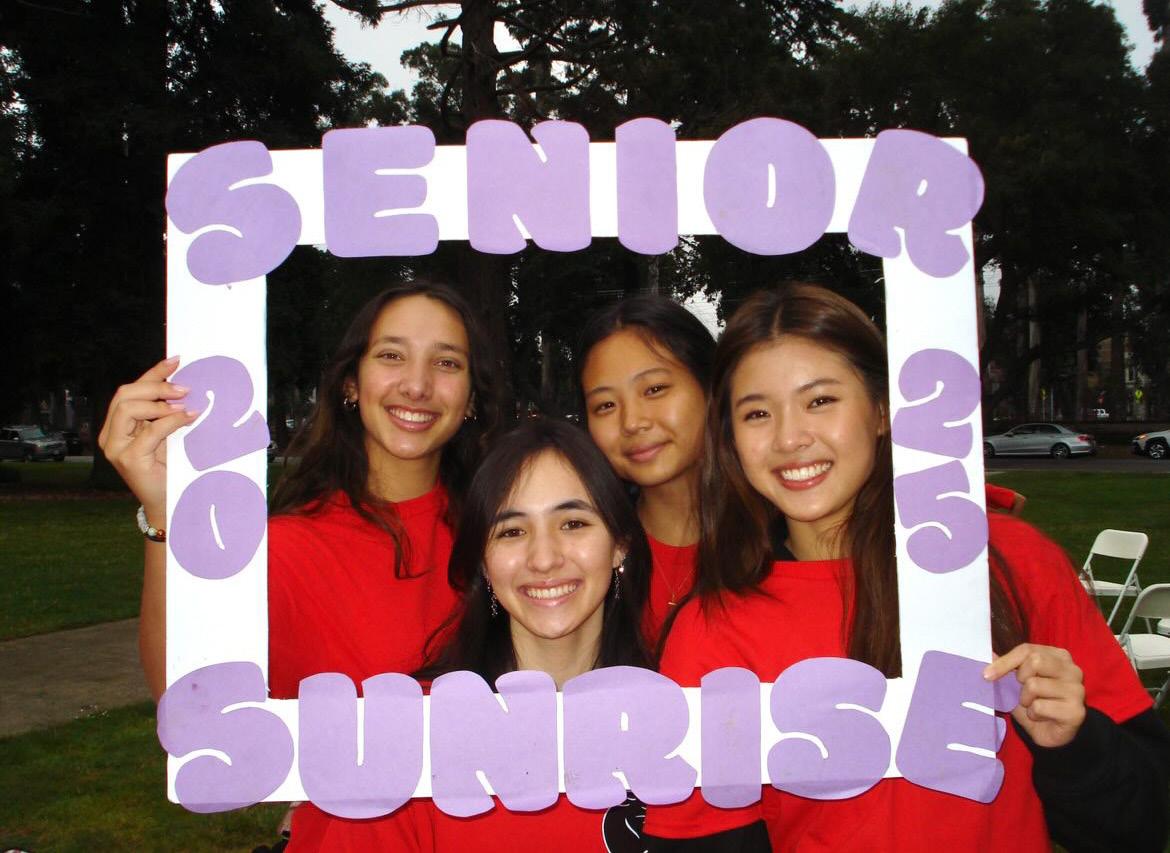
As the event came to a close, students picked up their red senior t-shirts, gathered for a group photo on the front steps of the school, and wrapped up the morning with a gift card raffle.
“It was pretty successful, despite not really being able to see the sun. I think people were excited to be there, especially since they know this is our last year, and this is our first senior event of the year,” Levitt said.
